Albuquerque Museum – Best in New Mexico
In a previous post I wrote about how Alison and were blown away by the El Paso Museum of Art during out stay in the city for the 2019 SATW conference. Frankly, we had not been prepared for such a fine display of art in what is an unfairly overlooked city by tourists. After the conference we rented a car and spent two weeks touring the great state of New Mexico, arriving after about ten days in Albuquerque. Not only did the city, like El Paso, surprise us with its charm and unexpected urbanity, but once again we we more than a bit impressed by the excellent Albuquerque Museum. It is a combined history museum and art gallery that almost seamlessly blends the two and uses modern curative techniques to make the experience great for people of all ages. So please join Alison and me as we tour the Albuquerque Museum.
Albuquerque Museum – General Information
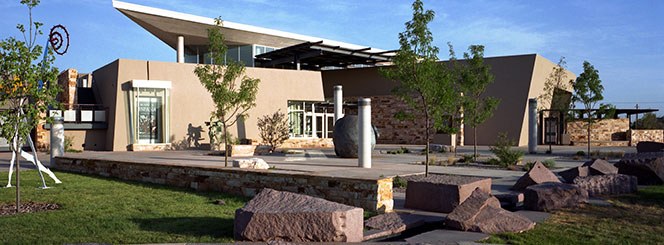
This is a photo of the Albuquerque Museum I took from their website as it’s virtually impossible to get a decent exterior shot with a normal lens. Also, as you move around the building the architectural style changes. Here is the museum exterior from another angle.
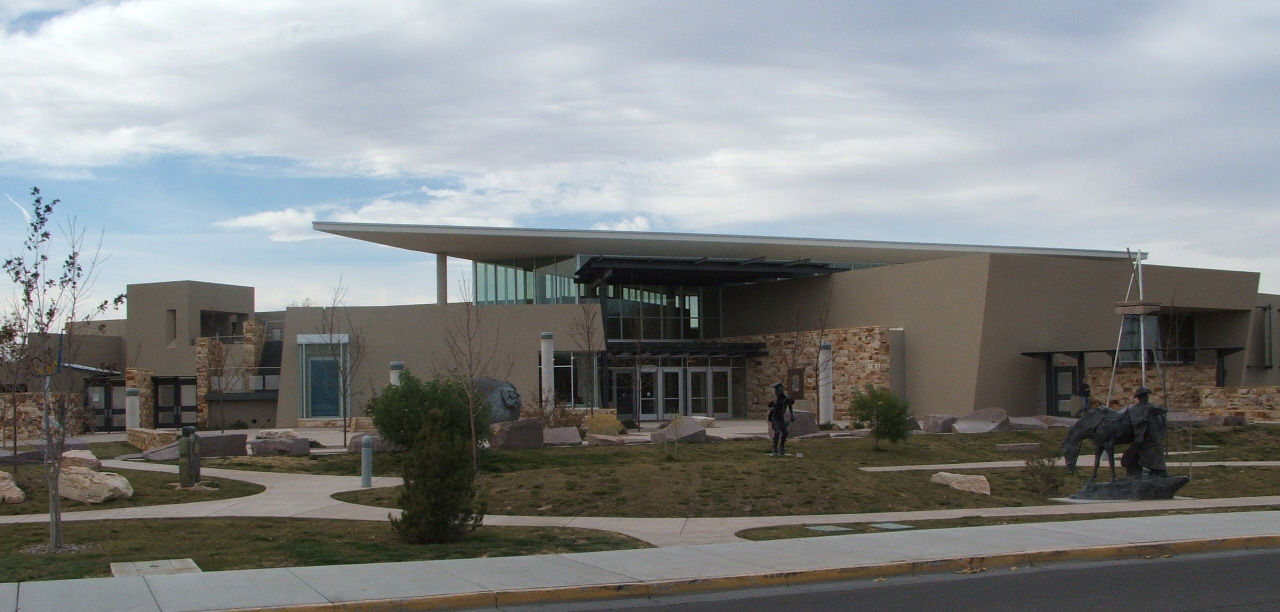
The building was originally opened in 1979 to a design by Albuquerque native Antoine Predock who was just embarking on a career that would see him create or collaborate on some of the most iconic museums in the world culminating in what I think is the finest piece of architecture in Canada – The Canadian Museum for Human Rights in Winnipeg. Already in 1979 he was exhibiting his penchant for combining different materials, different angles and curves and various ways to use light that he claims come from just observing the natural landscape of New Mexico. Until I began research for this post, I had no idea that the same architect was responsible for both this museum and the one in Winnipeg, but once you know that, the similarities are obvious. Predock’s design of the Albuquerque Museum fits in perfectly with its surroundings on the edge of Old Town. It both blends in with and complements the much older buildings nearby. A lesser architect might have attempted to build something that was out of scale and sync with Old Town. The bottom line is that it is a very well done indeed.
The museum is essentially divided into three parts – the exterior sculpture gardens and the art gallery and history museum on the inside. Let’s start with the sculptures which are more than worth exploring even if you don’t plan to go inside. Plus their free.
The Albuquerque Museum Sculptures
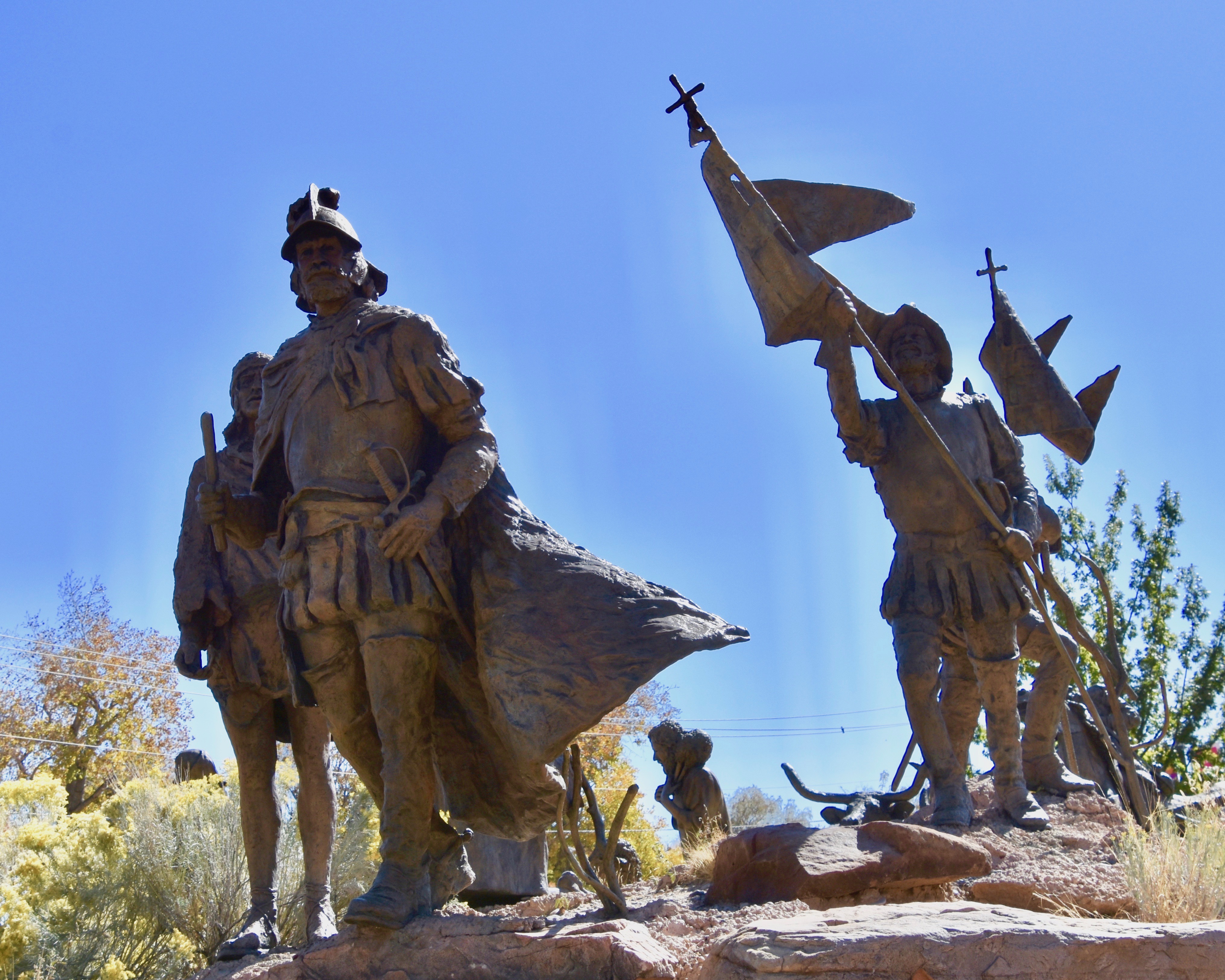
This is the leading edge of one of the most remarkable pieces of sculpture I have seen anywhere, La Jornada, the combined work of sculptors Sonny Rivera and Betty Sabo. The work is amazing not just for its epic effect, but even more so by the fact that it ever was commissioned. The figure at the forefront is Juan de Oñate, often referred to as ‘The Last Conquistador’. In 1598 he was granted permission by the Spanish to lead an expedition from Mexico into what is now New Mexico and bring ‘civilization and the Word of God’ to the people who had been living there for millenia. Among the tribes of the southwest he is remembered as being the perpetrator of the Acoma Massacre that resulted in the slaughter of over 800 people at the Acoma Pueblo including 300 women and children. Survivors, and that is an apt term in this case, were sold into slavery and some had their right legs cut off. Not exactly a guy you would think they would be building statues of in the 21st century.
But here’s the thing. A great number of people in New Mexico trace their ancestry and their history back to La Jornada and while they don’t want to expunge the horrific actions of Juan de Oñate, neither do they want to be told that they don’t belong here or that their story is secondary to anyone else’s. Thus, over the objections of many, the New Mexico Hispanic Culture Preservation League managed to get the story of La Jornada set out in plain view in a series of life-size sculptures that are inescapable as you head to the Albuquerque Museum entrance. Frankly, they are entrancing and you will want to walk around them to appreciate them from all angles.
Behind Juan de Oñate are these conquistadors and the priest Fray Alonso Martínez who was in charge converting the people of the pueblos, whether they wanted to be or not.
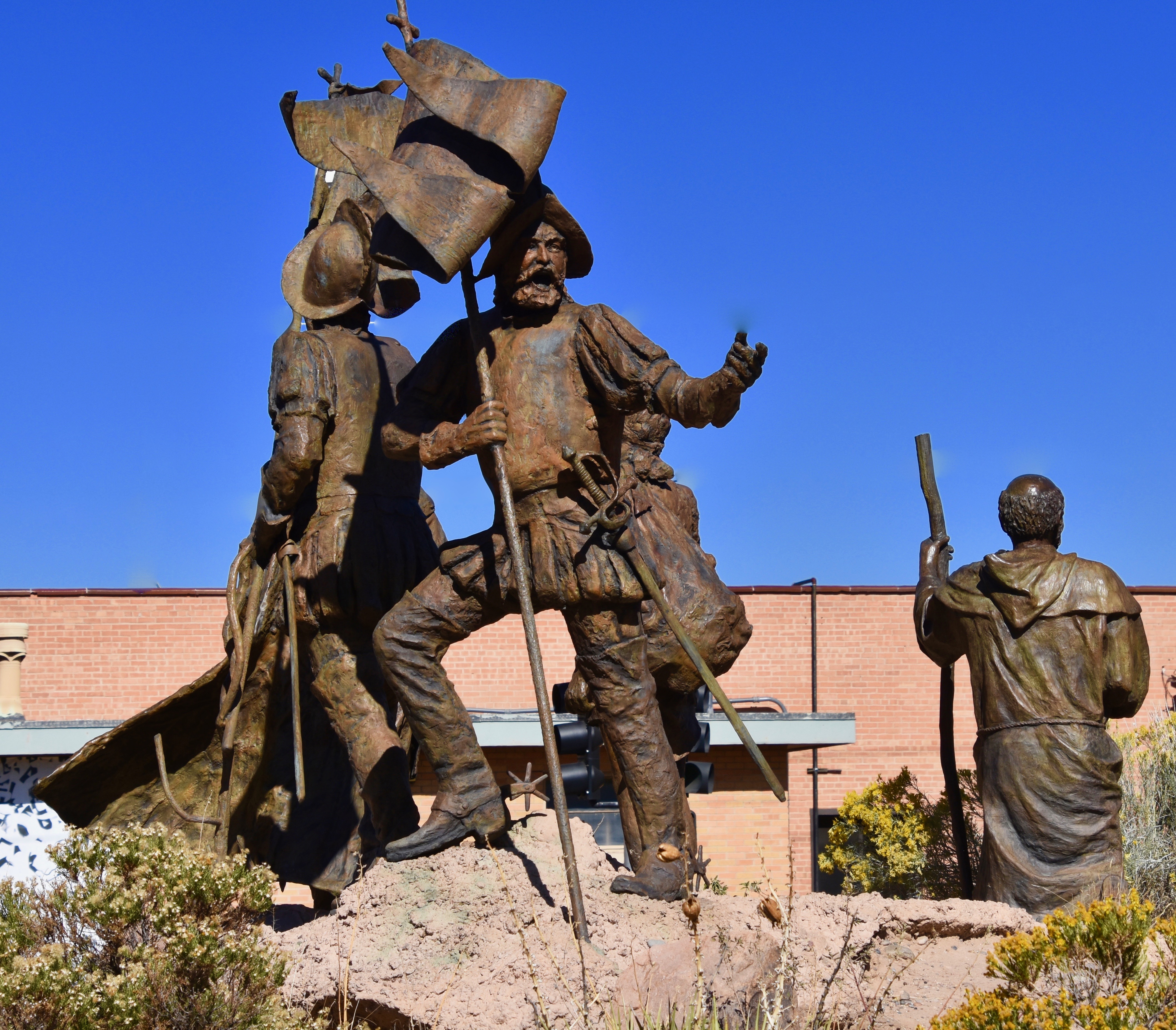
Next are representations of a few of the eighty-three ox carts that brought provisions from Mexico and introduced many food items that have become staples of New Mexico cuisine. The way they are portrayed in the midst of desert plants and native rock adds a great deal of authenticity to the work.
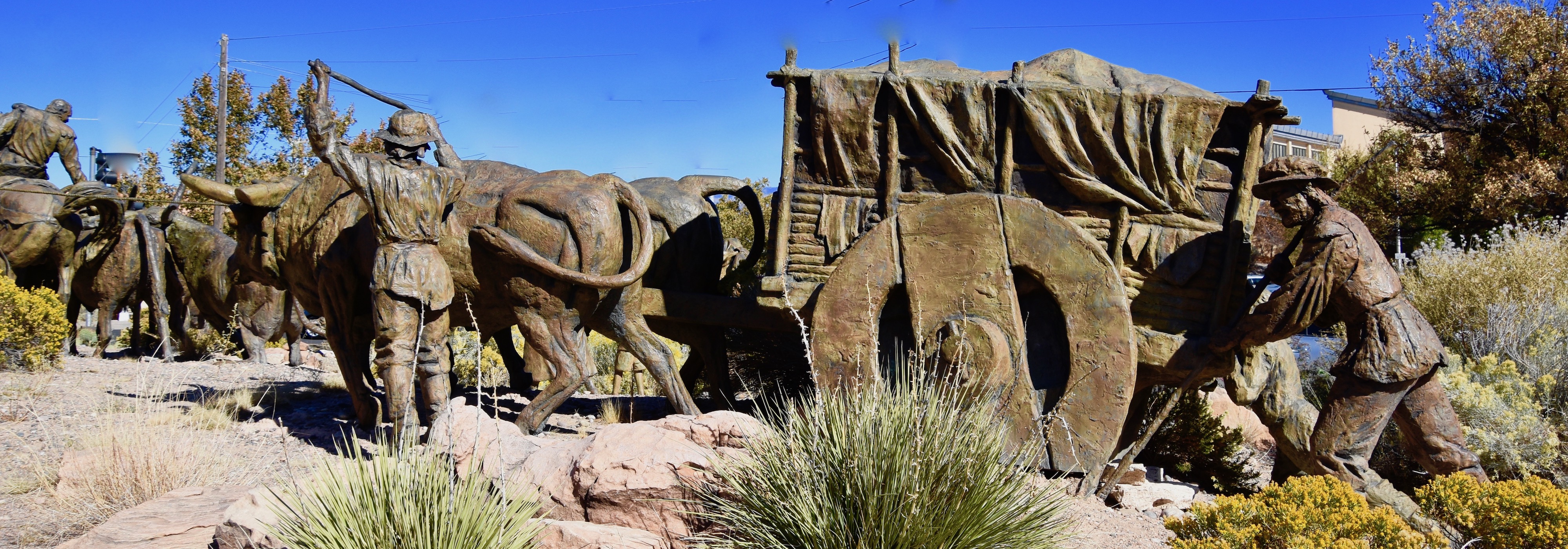
They brought not just oxen, but longhorn cattle and their herders as well. These would be the first vaqueros in the southwest.
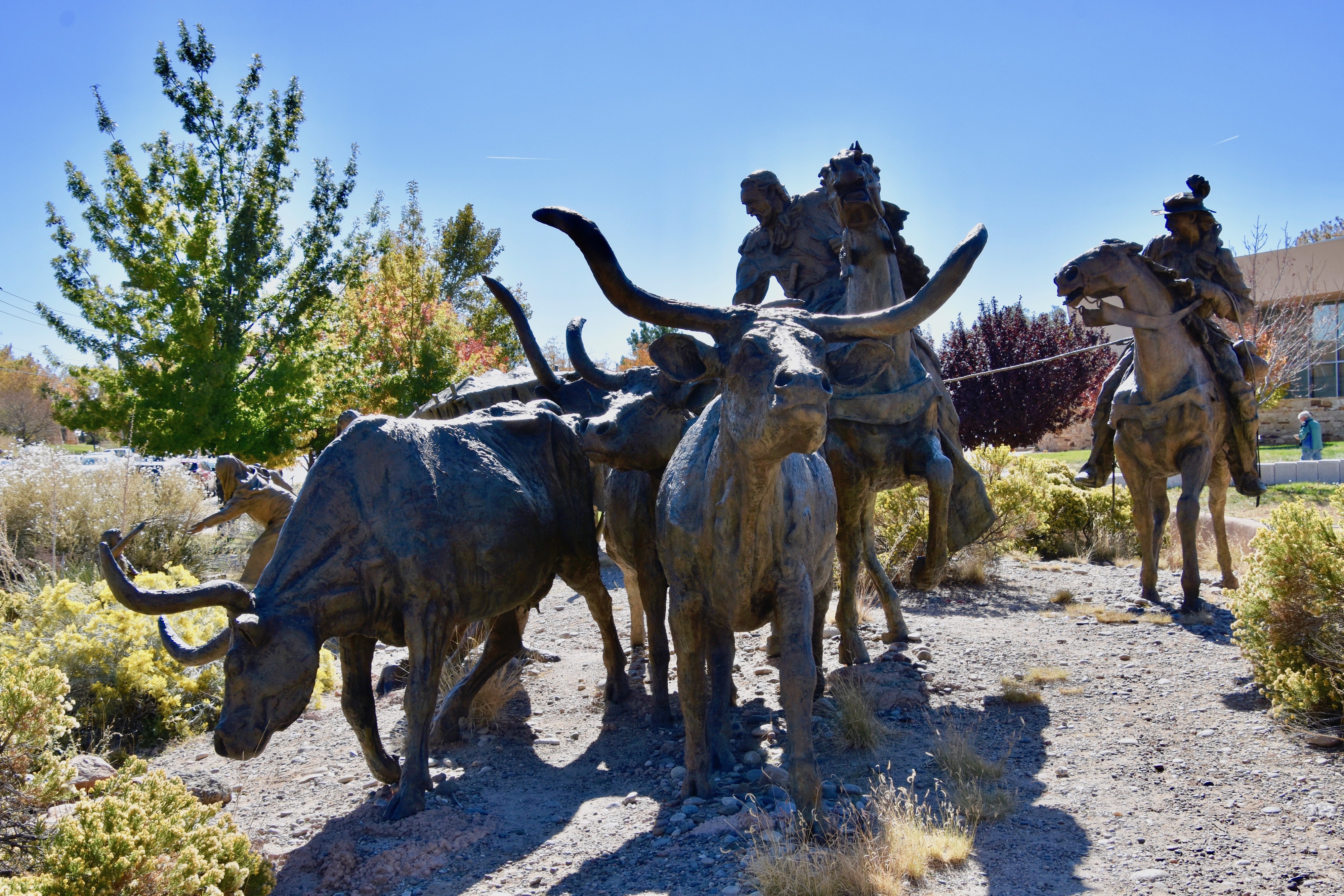
It was not just men who made this journey, but women and children as well, which adds a humanizing element to what otherwise would have been just a brutal conquest. It was through these women and children that the present day Hispanics of New Mexico trace their roots and without their presence, I doubt that the La Jornada statues would ever have been constructed.
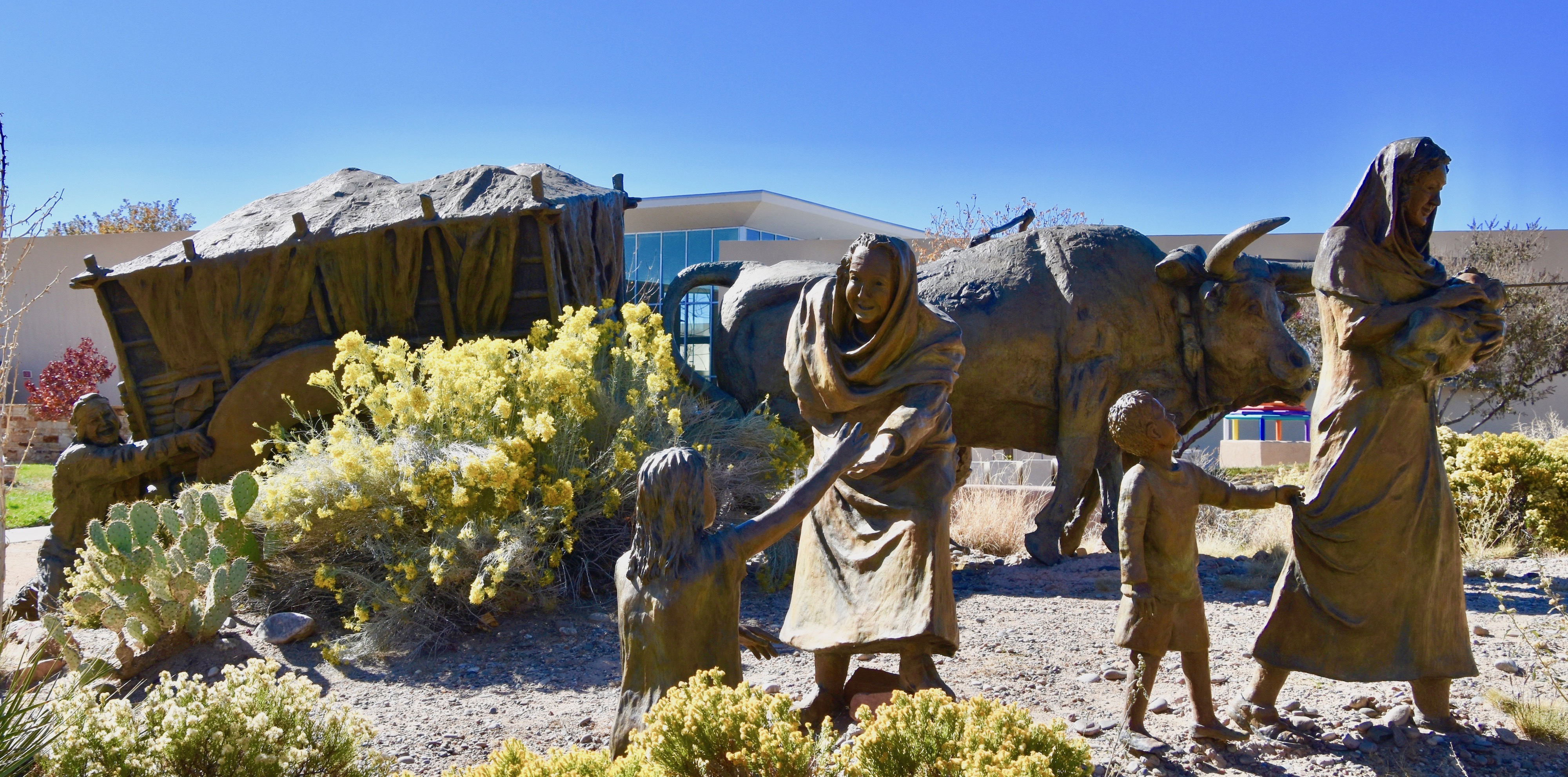
One of the most notable women on La Jornada was Doña Eufemia, pictured here on the donkey, who was renowned for her courage and determination in urging the group to keep going when many wanted to turn back.
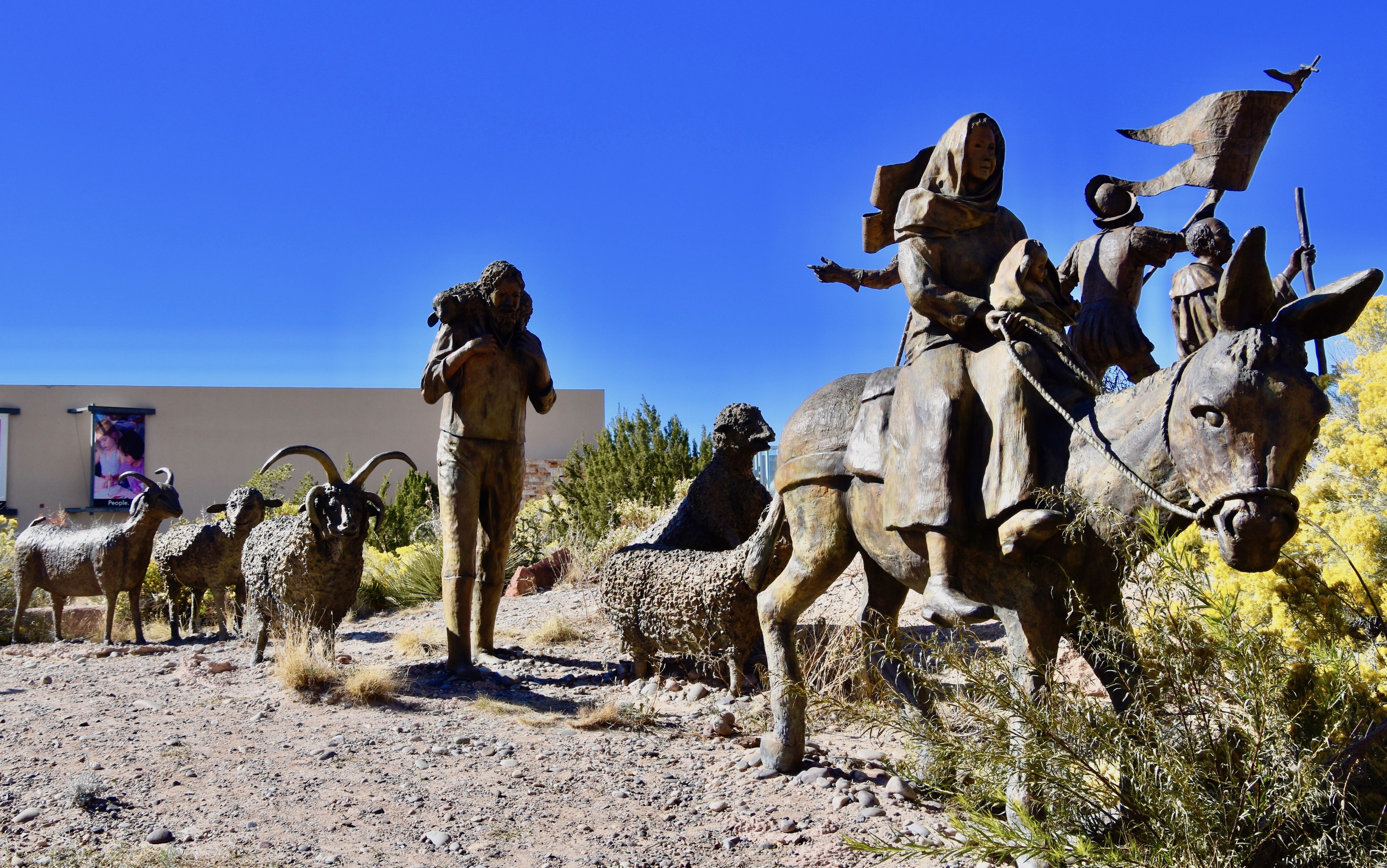
I can’t stress enough how powerful and spellbinding La Jornada is, but it is not the only noteworthy sculpture on the grounds of the Albuquerque Museum, all less controversial I am sure. This is Glenda Goodacre’s Park Place which invites one to join this group of park users in the daily routines of modern day life. Goodacre is best known for designing the Sacagawea silver dollar and the Vietnam Women’s Memorial in Washington.
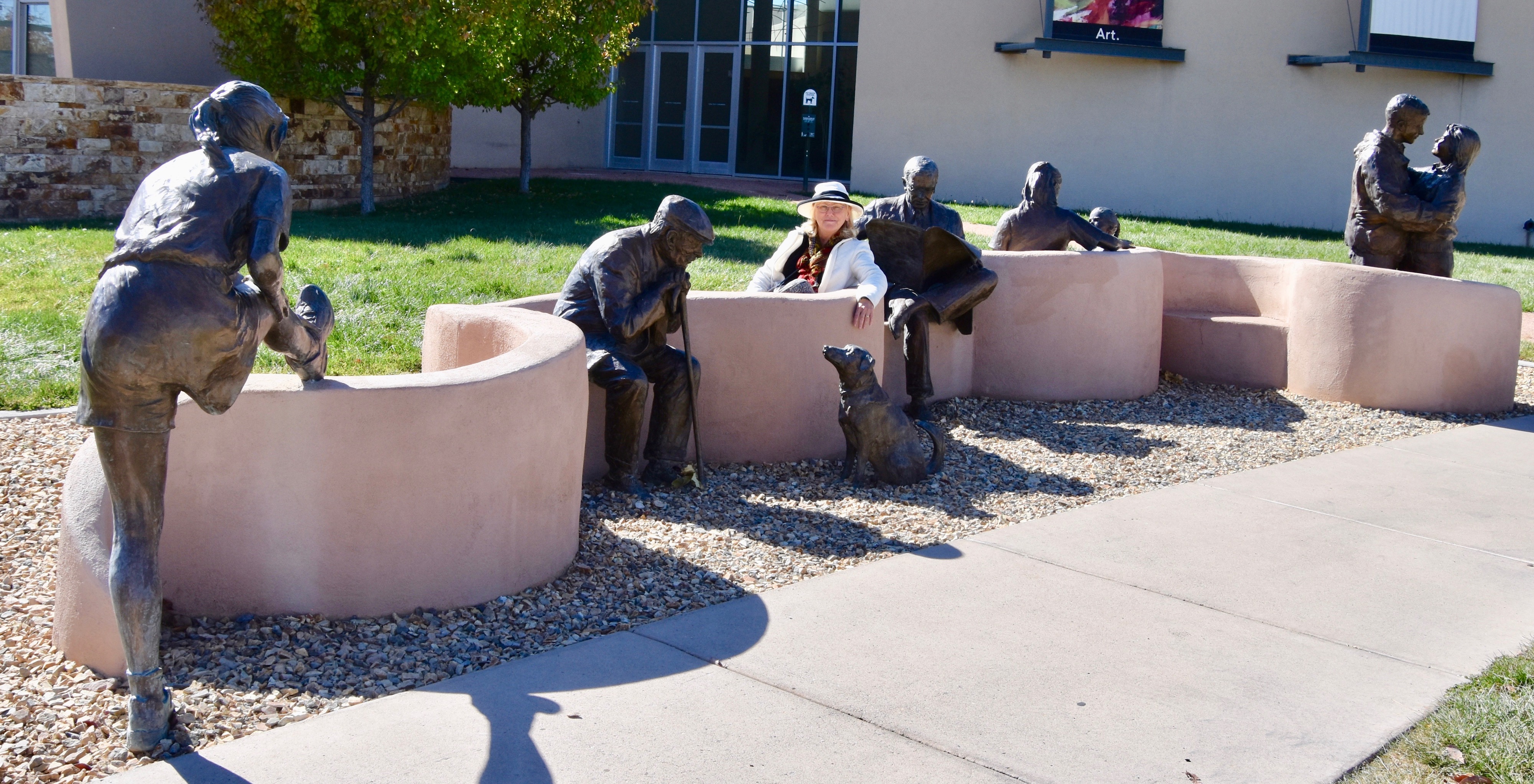
You can’t have a western sculpture garden without a cowboy and William Moyers‘ Wind and Rain fits the bill perfectly.
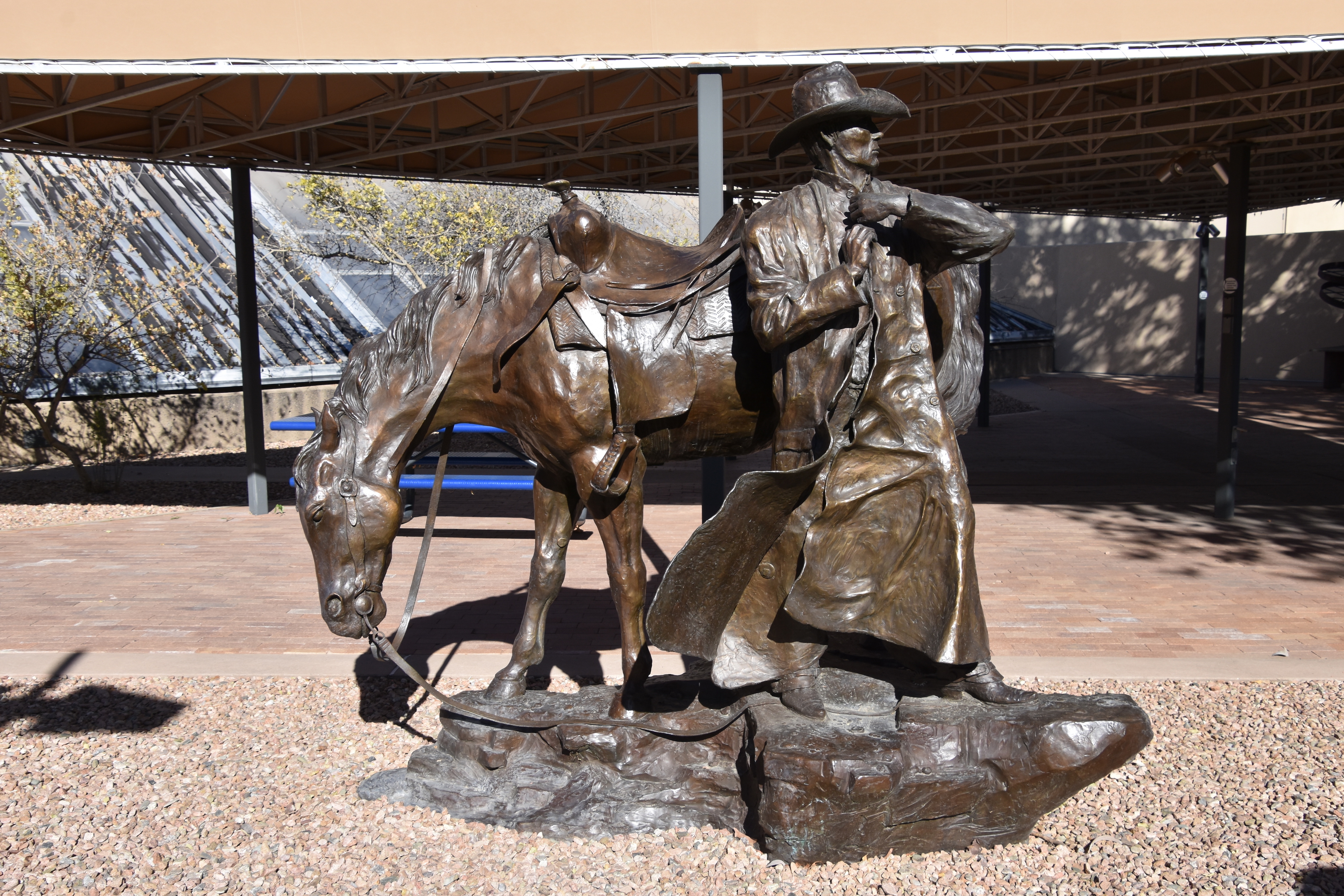
Just like you can’t have a western sculpture garden without a cowboy, neither can you have one without an Indian. BTW, before you take umbrage at the word ‘Indian’, please be aware that this is how the aboriginal people of New Mexico often refer to themselves. They do not see it as a pejorative term as others do in other places.
This is Chiricahua Apache sculptor Allan Houser’s powerful The Prayer and I’m pretty sure he’s not praying to the same god as Fray Martínez believed he should be.
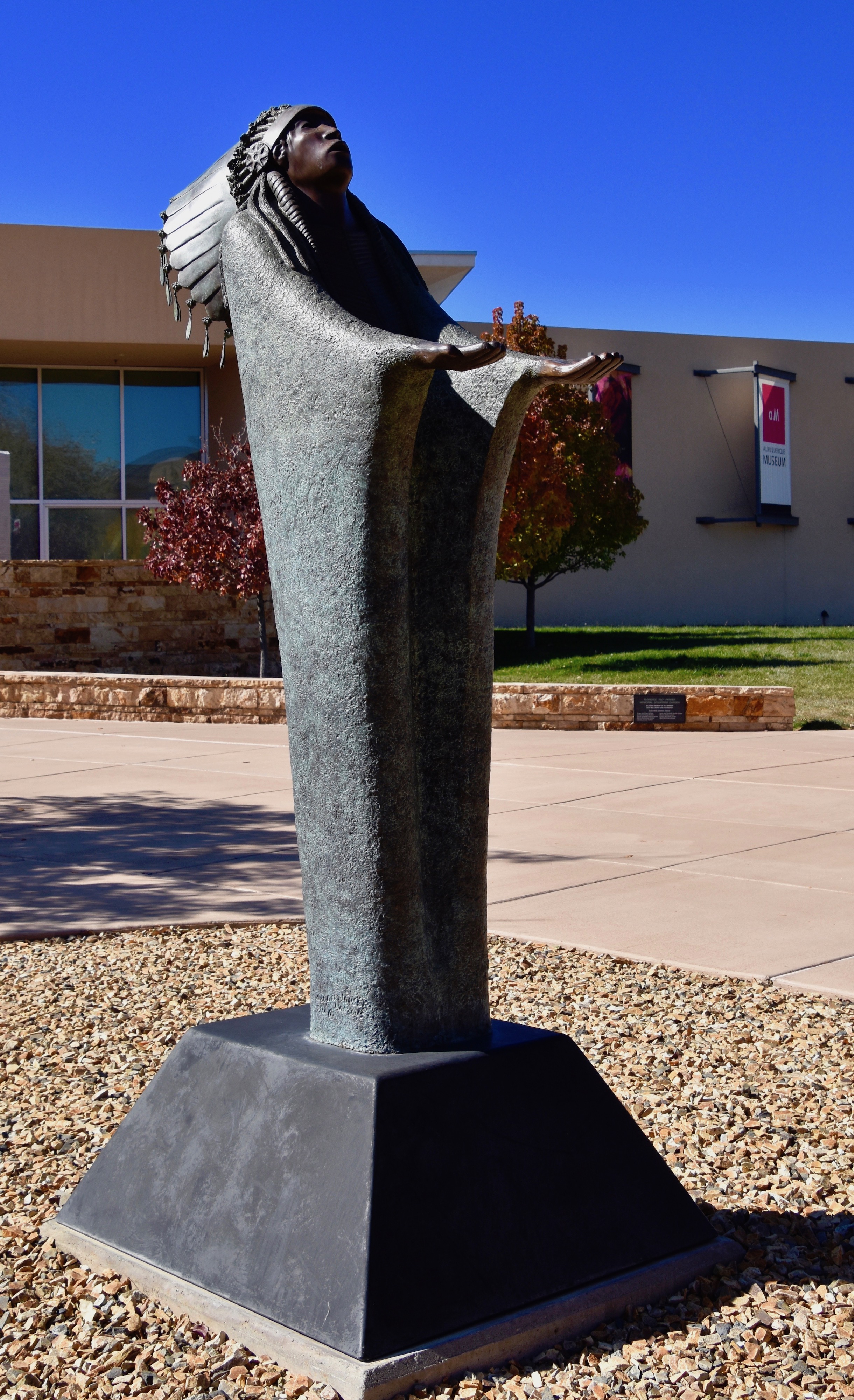
I’ve had my picture taken with Cervantes or his creation Don Quixote in a number of places, but I did not expect to find his head here in Albuquerque, but then, why not?
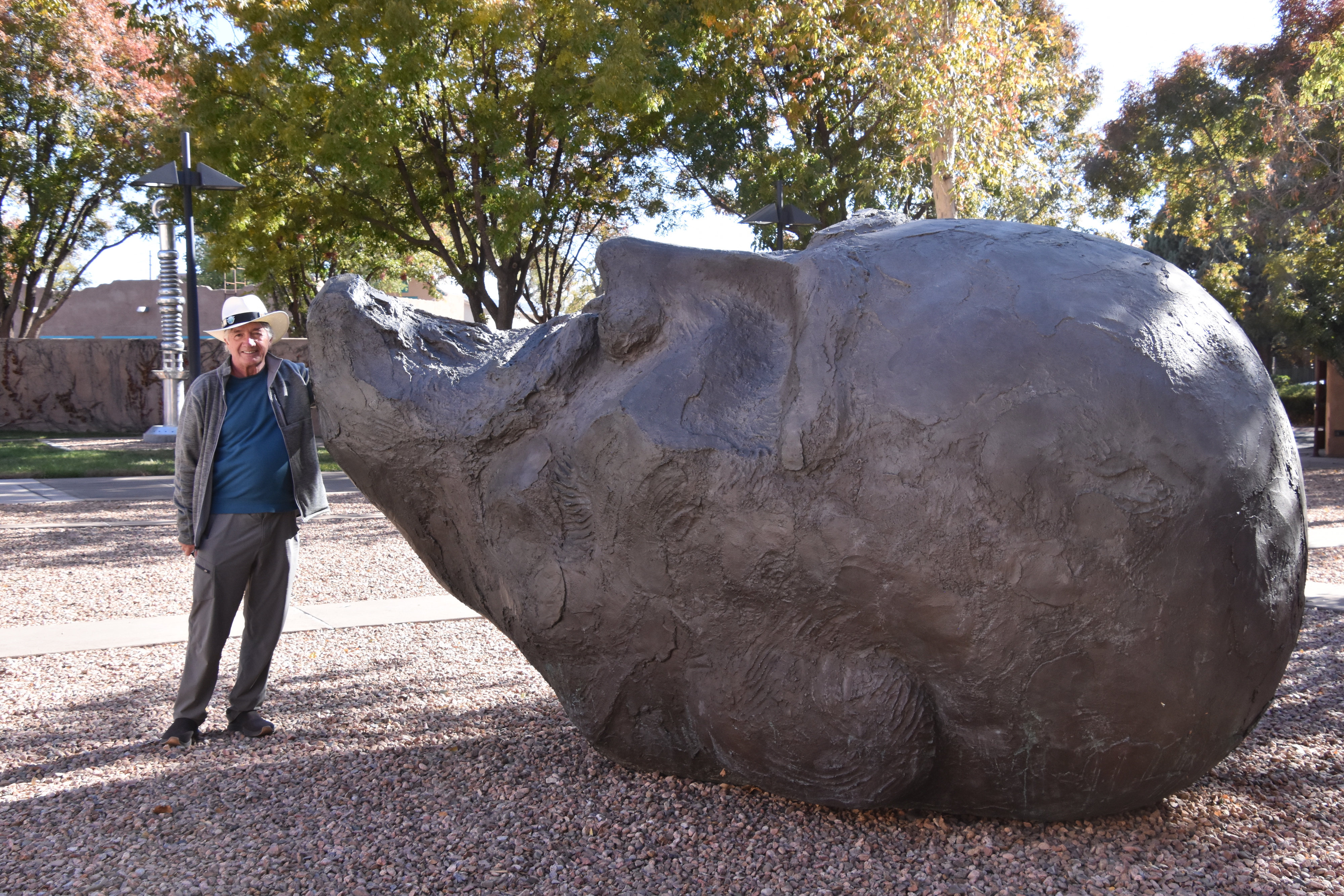
All told there a fifty three works of art in the sculpture garden and I could easily do a post just on those alone, but it’s time to go inside so I’ll end of with these metallic dancers in John Massee’s Esperanza Bar.
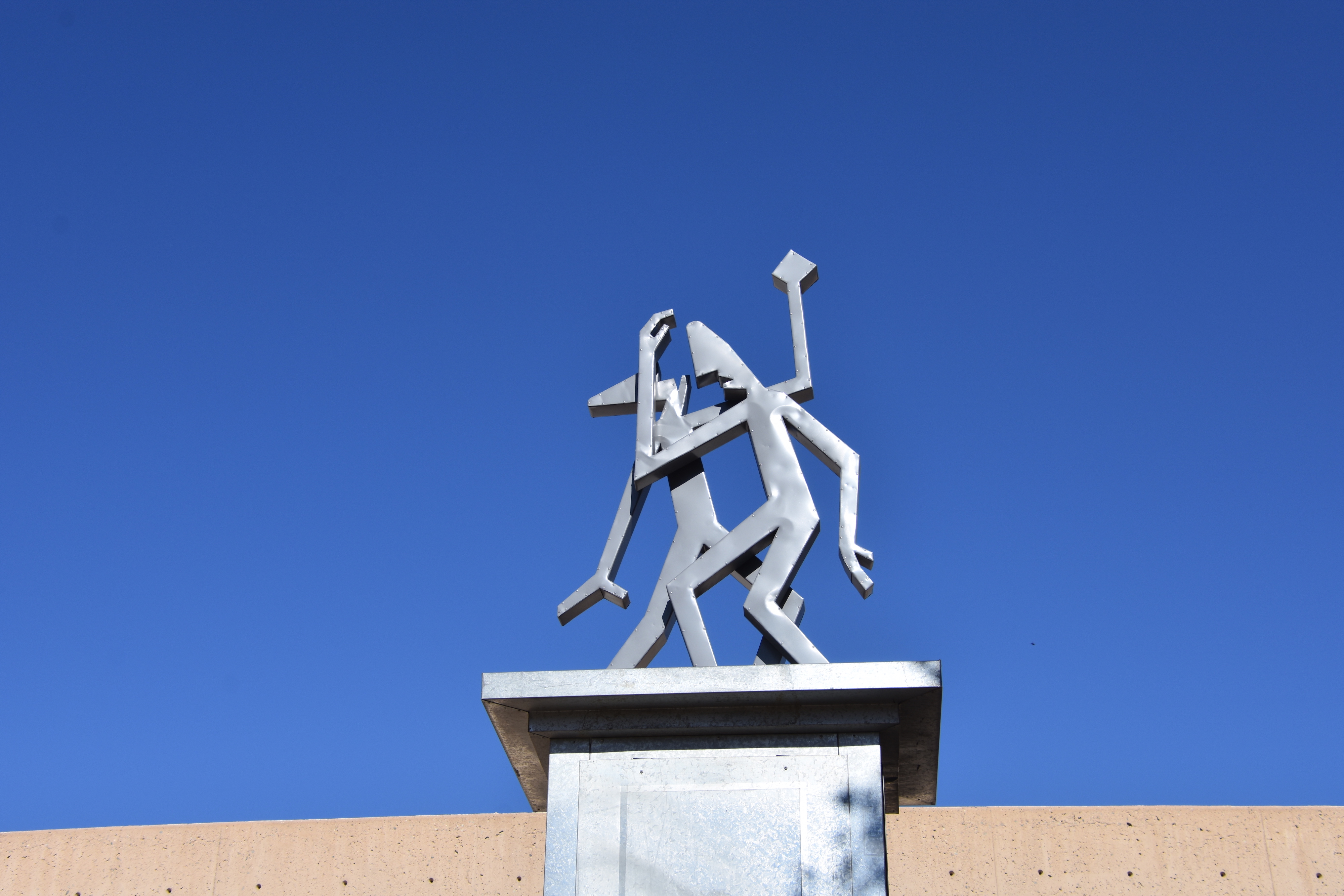
We are fortunate to be here on a Sunday morning when admission is free, but even if we had to pay it’s only $6.00 or $4.00 for seniors.
There is only one floor and seven galleries which can be visited in a counter-clockwise rotation starting with the art galleries and ending with the history displays which are in one huge multi-roomed gallery Only in Albuquerque.
However, before starting the exploration you will definite want to stop and make a quilt. Say what?
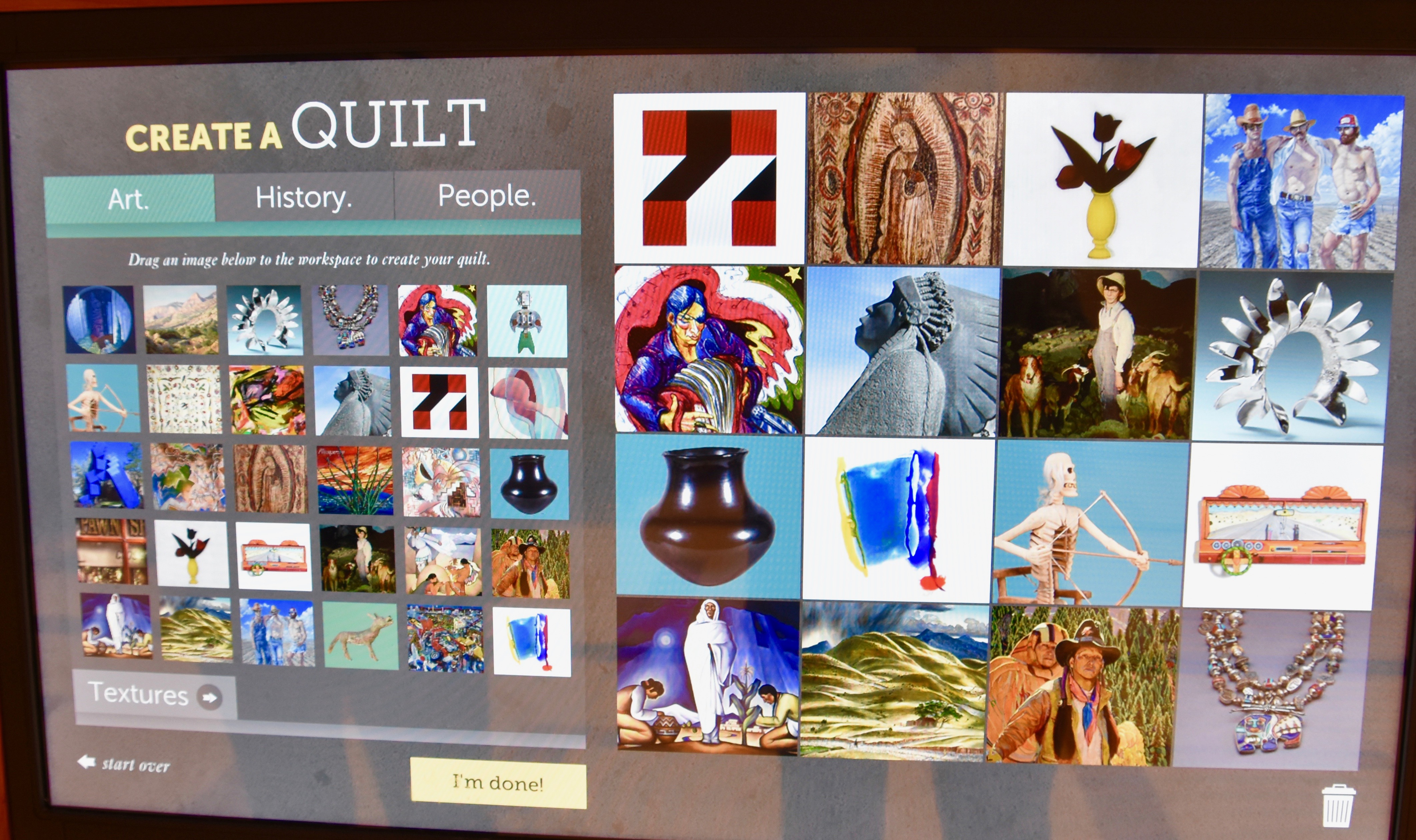
This is the interactive Create a Quilt display where you can scroll through some of the highlights of the museum and insert the ones you like and will definitely seek out during your visit, into your own quilt. Press the button when your done and voila, your own quilt shows up on a large screen. This is mine. If you like what you’ve done you can email it to yourself or others. Every museum should start of with one of these.
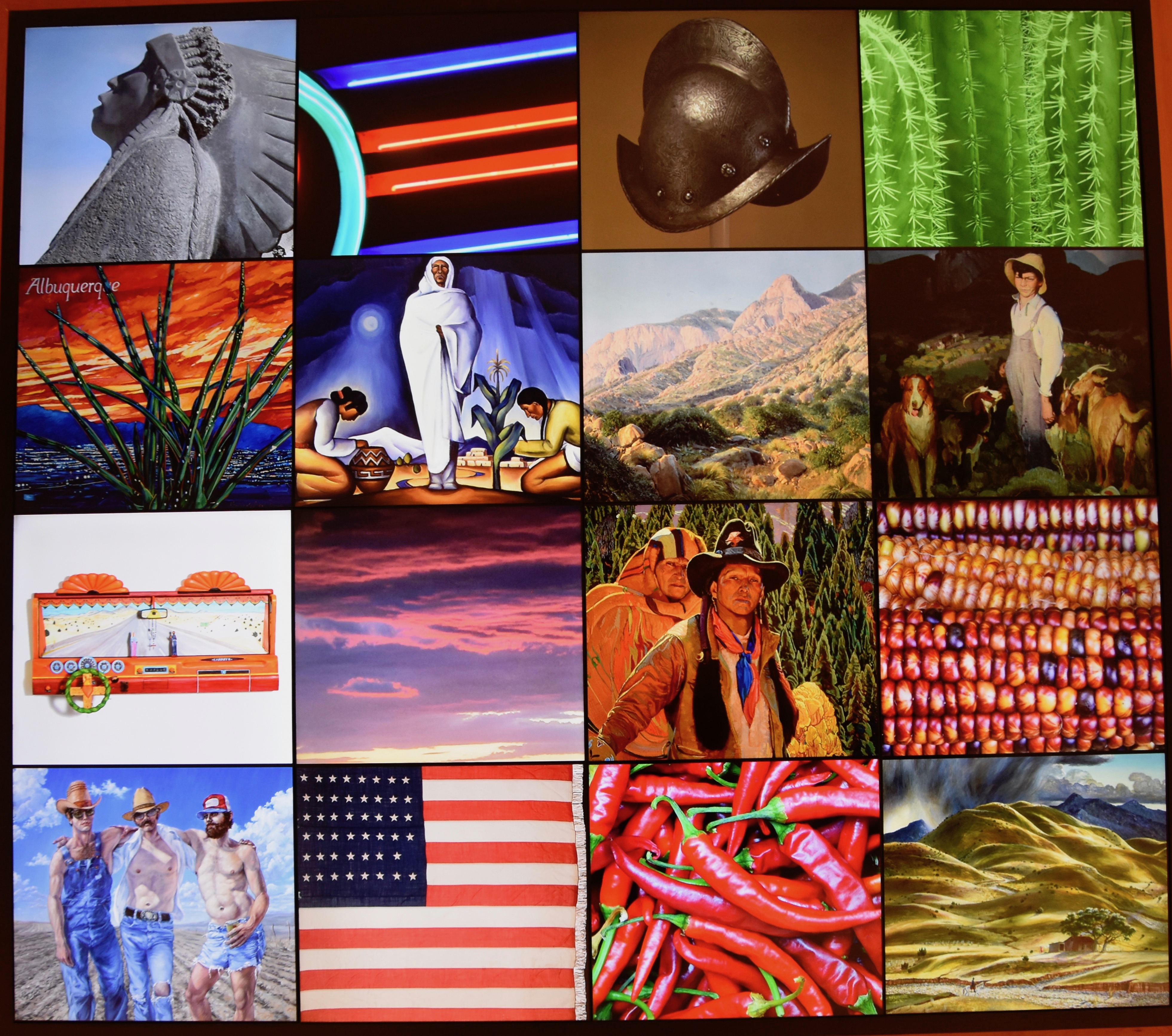
The Art Gallery
This is the entrance to the galleries where upon closer examination these brightly coloured wooden panels reveal many images typical of New Mexico.

What follows are some of what I thought were very high quality works of art, almost all by artists I had never heard of. If you are looking for Georgia O’Keeffe you need to go to Santa Fe.
This very large painting is just outside the first gallery. Scott Greene’s La Bajada Bluff is a reflection upon the cost of human consumption and waste that is pushing the bison off a cliff of modern garbage. The native hunters who once used to pursue bison in this manner are long gone, only to be replaced by crap. This painting makes you think.
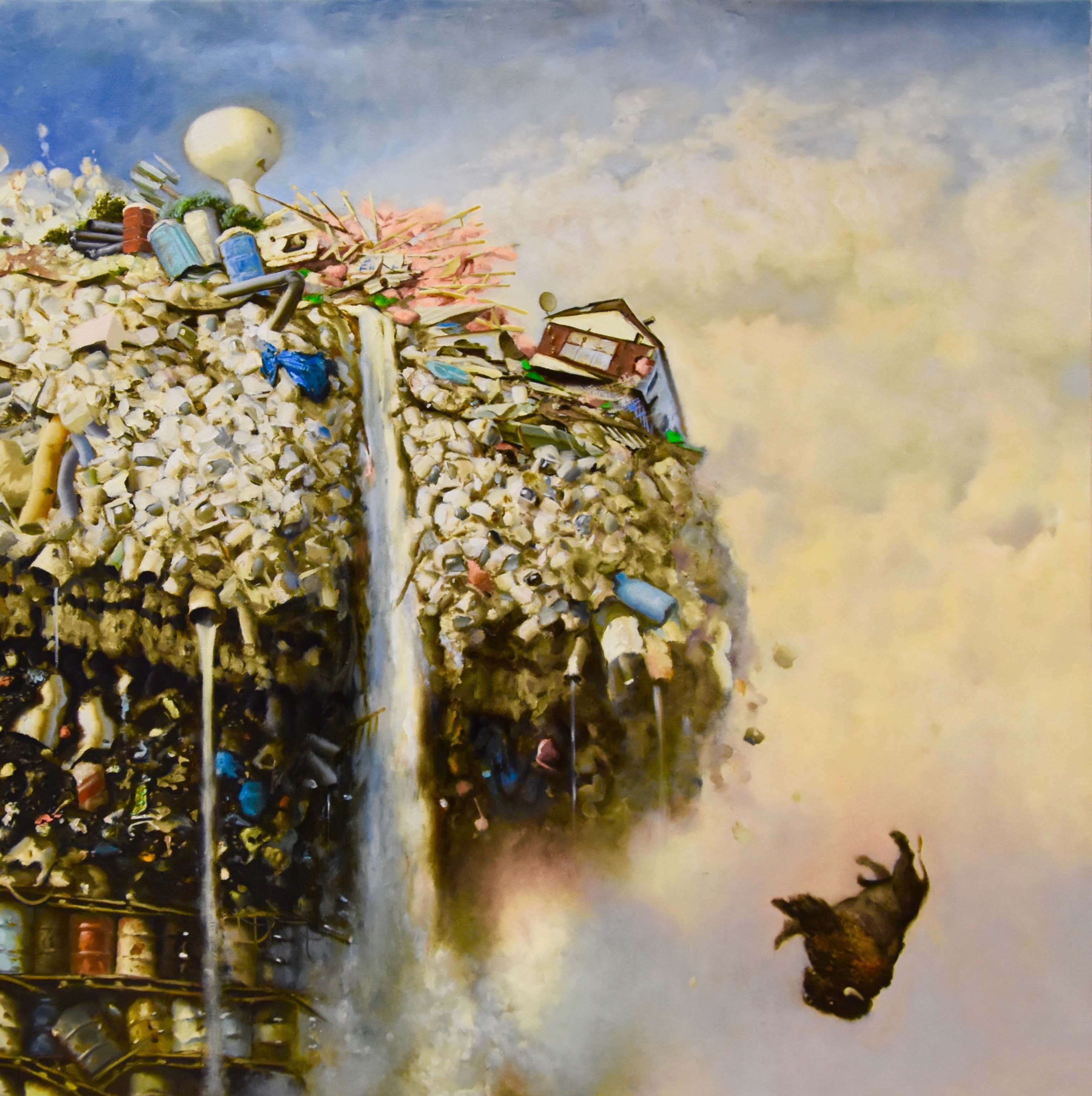
Not far from this painting is an even larger one, this one much more traditional in nature. This beautiful landscape, Late Afternoon at Cueva is by William Hurley whose work is evocative of 19th century American landscape artists like Albert Bierstadt. It is a fine contrast to the Scott Greene painting and sets the stage for the dichotomy of New Mexican art that is about to come.
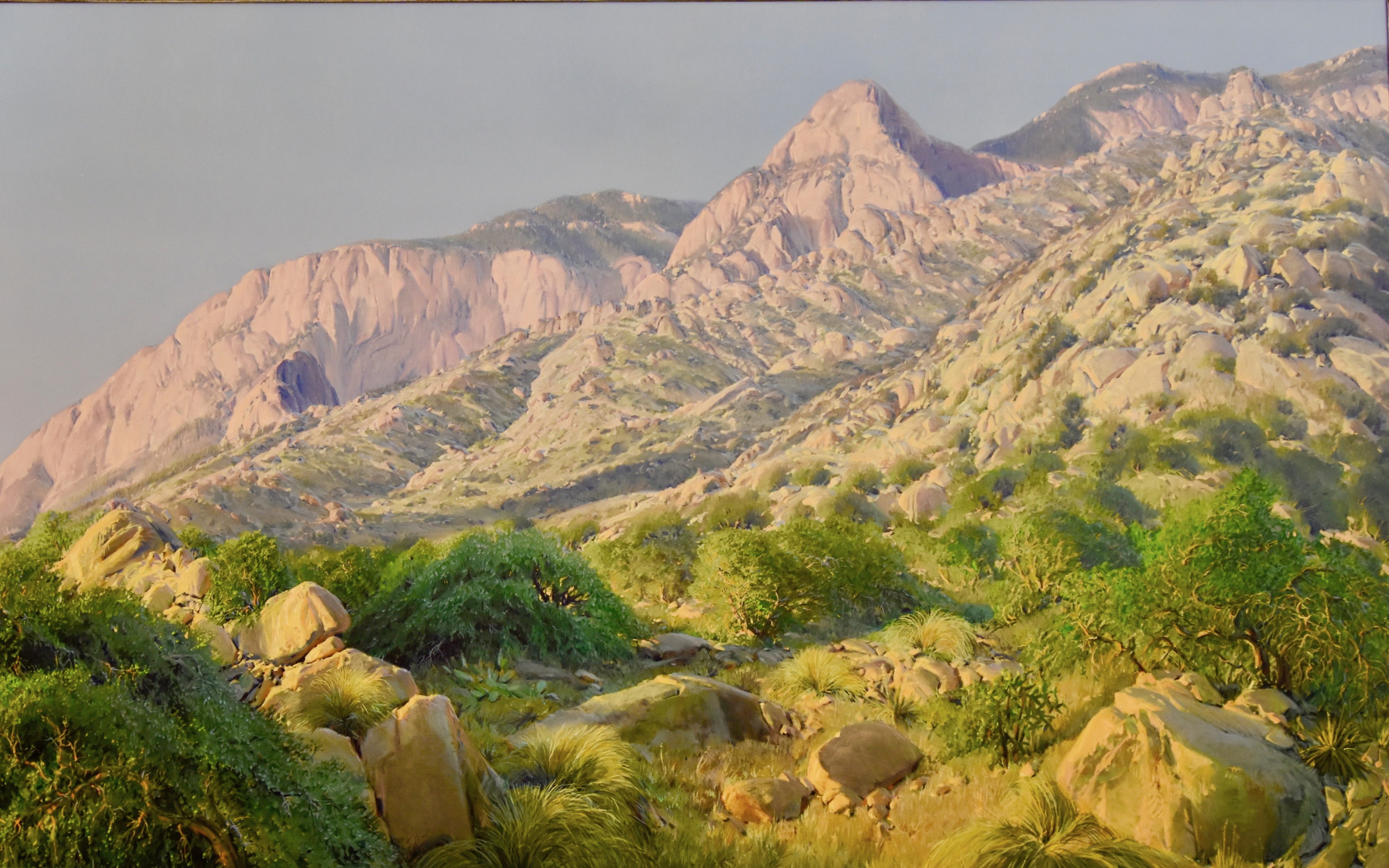
I should say that the presentation of the art at the Albuquerque Museum is about as well done as I’ve seen at any museum. Each piece is given its own sizeable space and its own explanatory card. Unless there is a reason to clump works together, which there is in a few cases, you can enjoy these works on their own without reference to any particular type of style or school. Let’s start with the mesmerizing stare of a coyote in Tom Palmore’s Survivor. He’s a specialist in painting animals, often in surrealistic surroundings, but this one nails the coyote as the ultimate animal survivor.
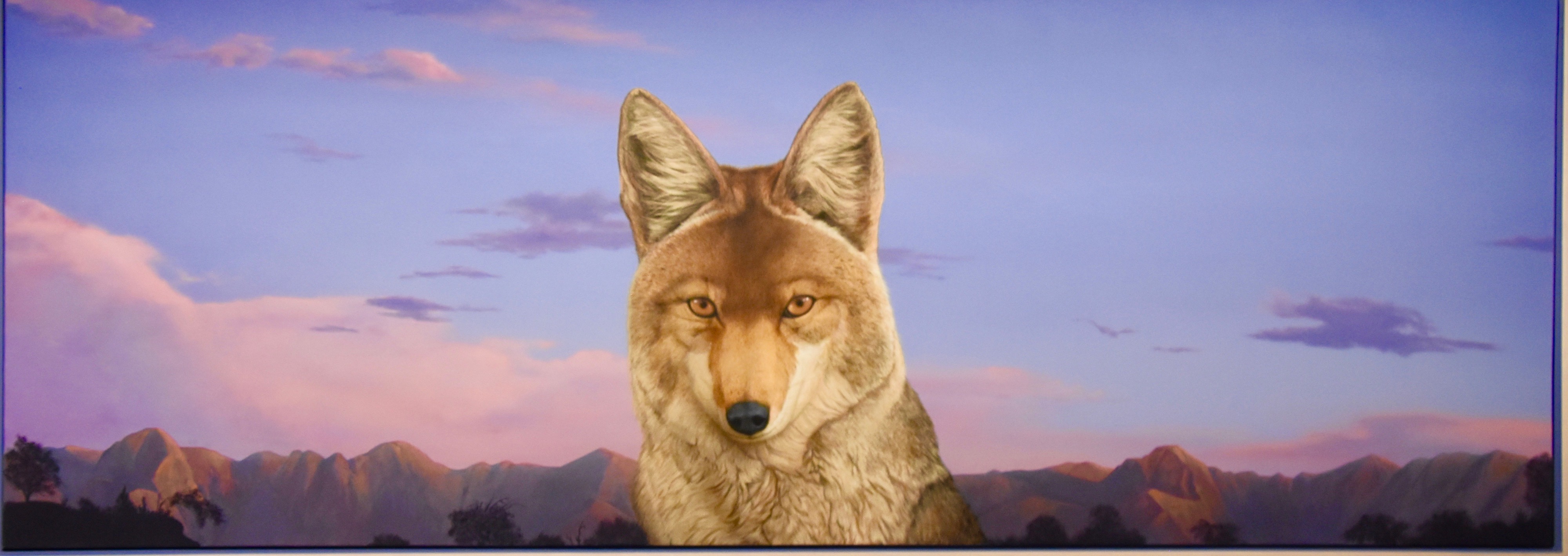
Just when I said the the paintings are not clustered together I contradict myself with this wall of self-portraits. But I did say there were exceptions to the rule and this is one right off the bat, but there are not many others. Somehow it seems appropriate to contrast the many styles of self-portraiture and raise the question – why do so many male artists think they look better with a pipe in their mouths? Do we blame Van Gogh for that?
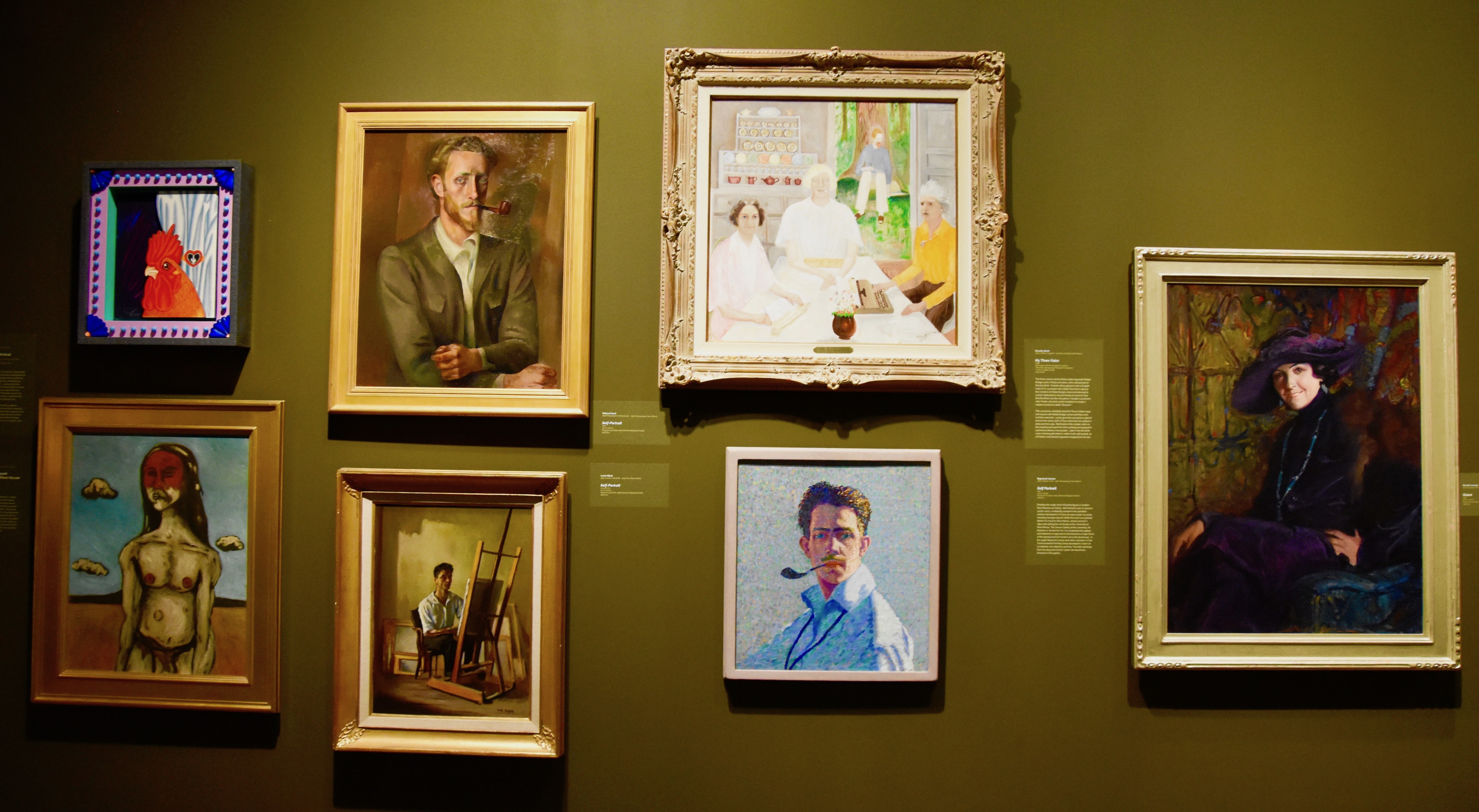
Back to individual works, these are Los Musicos by WPA artist Esquipula Romero who designed the frame as well to complement the rustic aspect of this work, although the guy on the left could have been less like Curly from the Three Stooges.
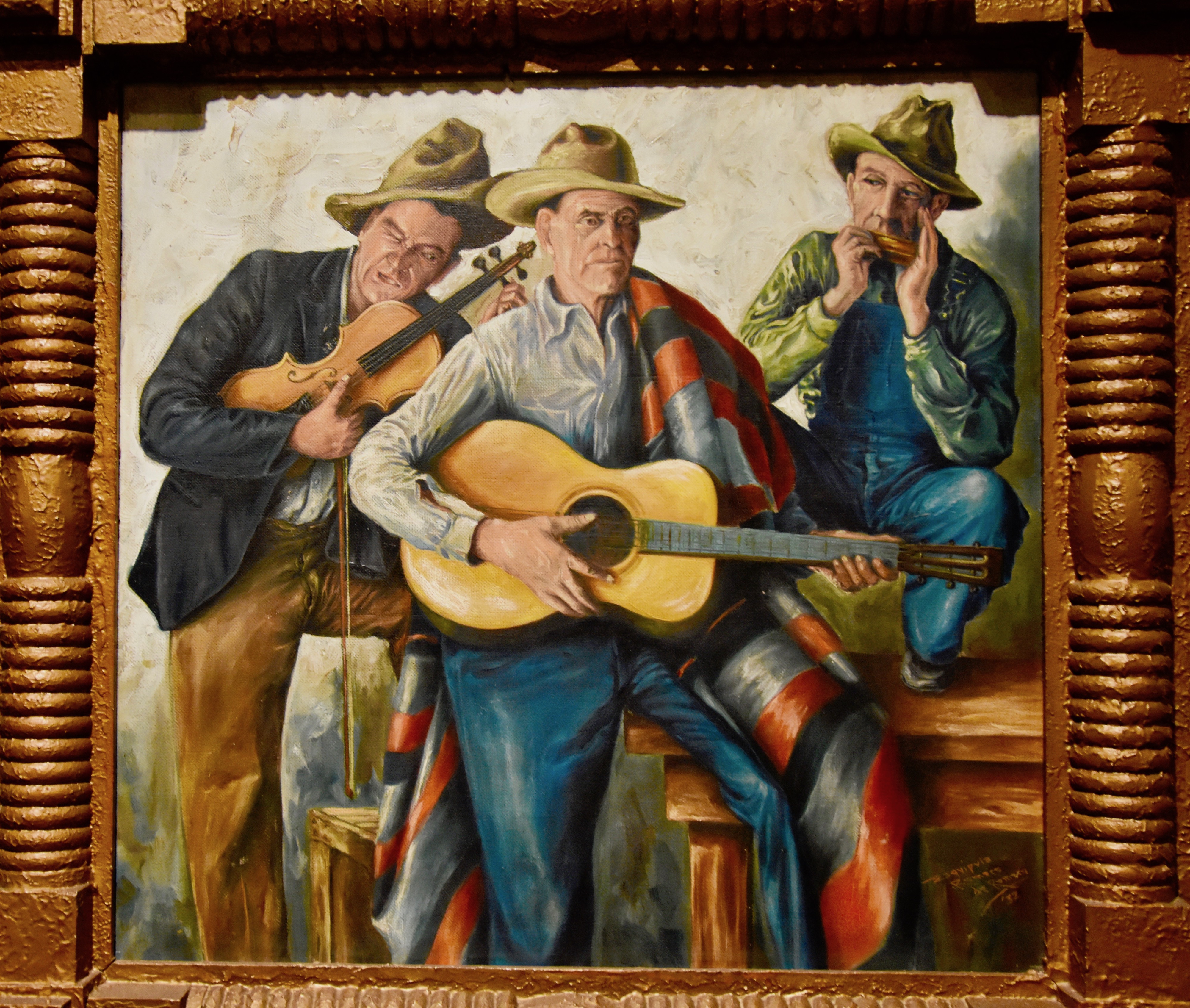
Next we have a sculpture from someone who, since coming to the southwest on this trip, has rapidly become one of my favourite American artists, Luis Jimenez. He could do things in fibreglass and other modern materials that are totally original and compelling. This is Howl and unlike Survivor which depicts the wily and unstoppable coyote, this is a Mexican red wolf which is on the edge of extinction, largely because of hybridization with coyotes. It is howling for its own very existence.
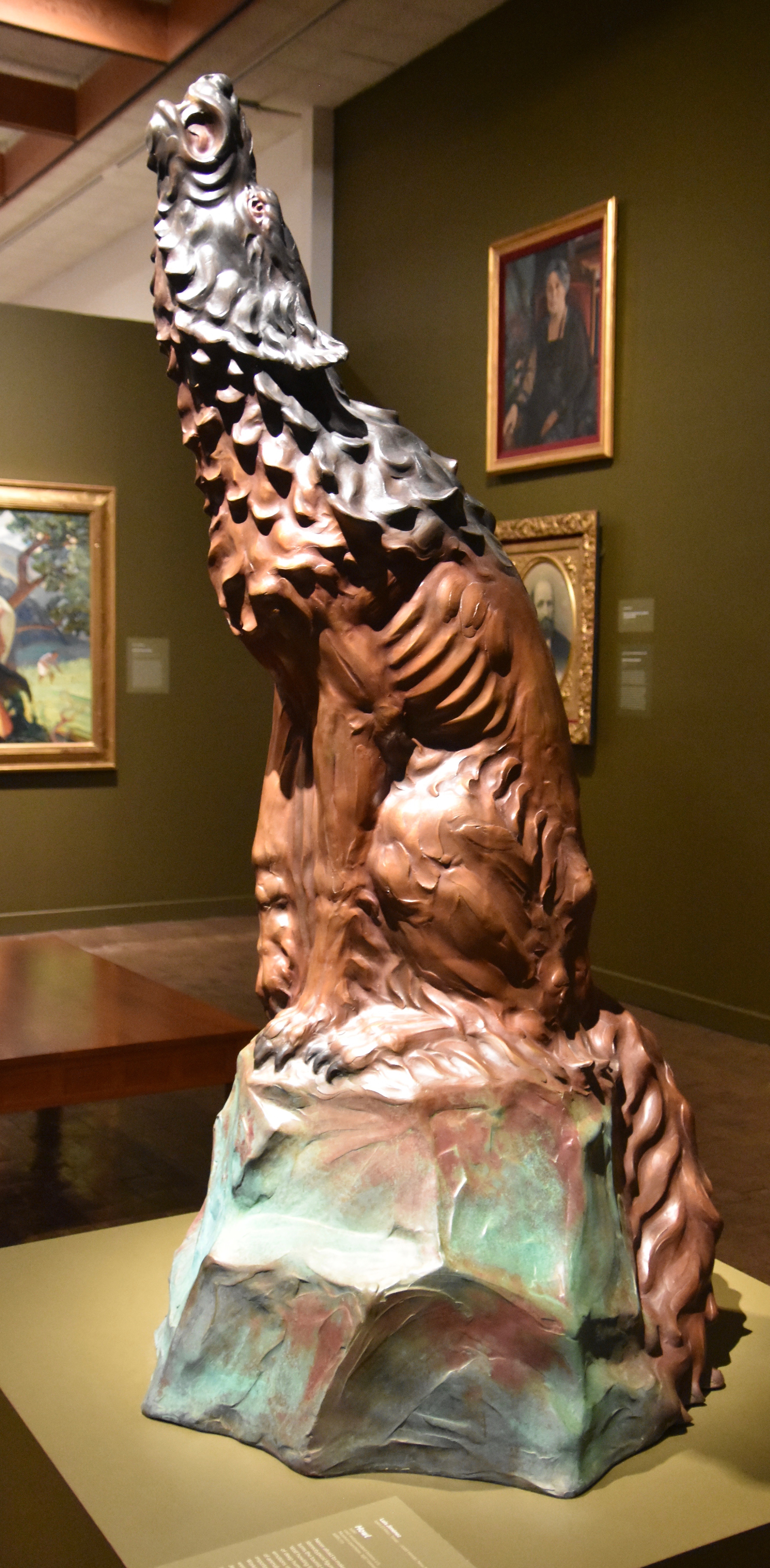
Here is William Dunton’s New Mexico Goatherd which some might find hokey while others, like me, enjoy it for it’s use of light and the lack of pretence that this is anything but just a painting about a boy, his dogs and his goats. Dunton was an early member of the Taos art colony and usually painted cowboys, but he was pretty good at commercially saleable paintings like this as well.
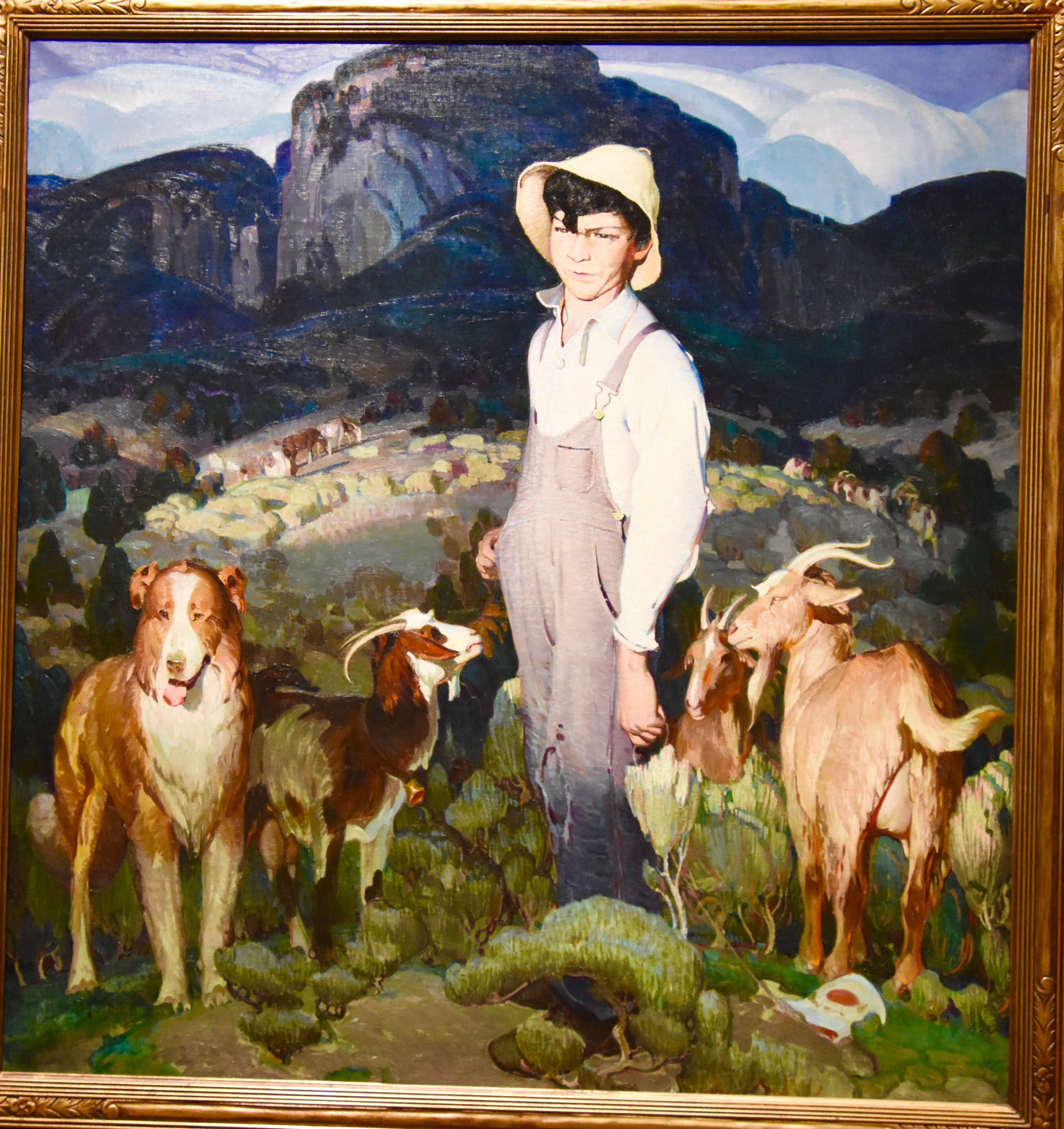
This is one of the paintings I picked out for my quilt and it is by another Taos art colony member Ernest Blumenschein who was known for his sympathetic portrayals of Native American subjects. This seemingly simple portrait of two men in fact has a deep symbolism to it. The older man in back is White Sun, dressed in traditional Native American garb while Star Road has a western cowboy type hat, a neckerchief and a modern leather jacket, albeit still sporting some Native American accoutrements. The younger man’s pose and his choice of apparel is literally eclipsing that of the older generation and a way of life. This is a really moving painting, perhaps the best in the collection.
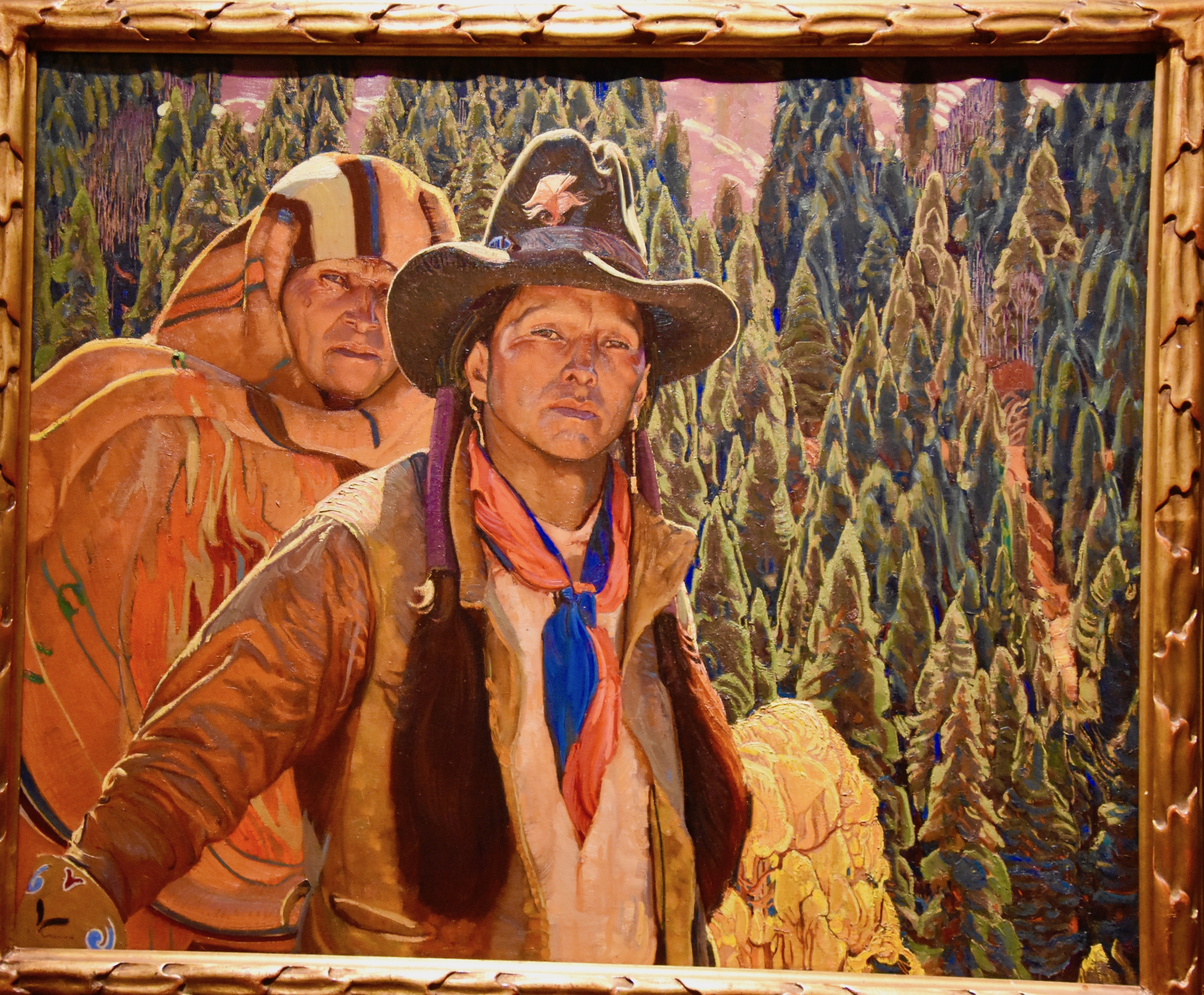
Having just visited Carlsbad Caverns a week of so before arriving in Albuquerque I was intrigued by this Ray Johnson triptych. While the colours of the caverns are not as bright as depicted by Johnson he does capture the magical atmosphere of the place very well.
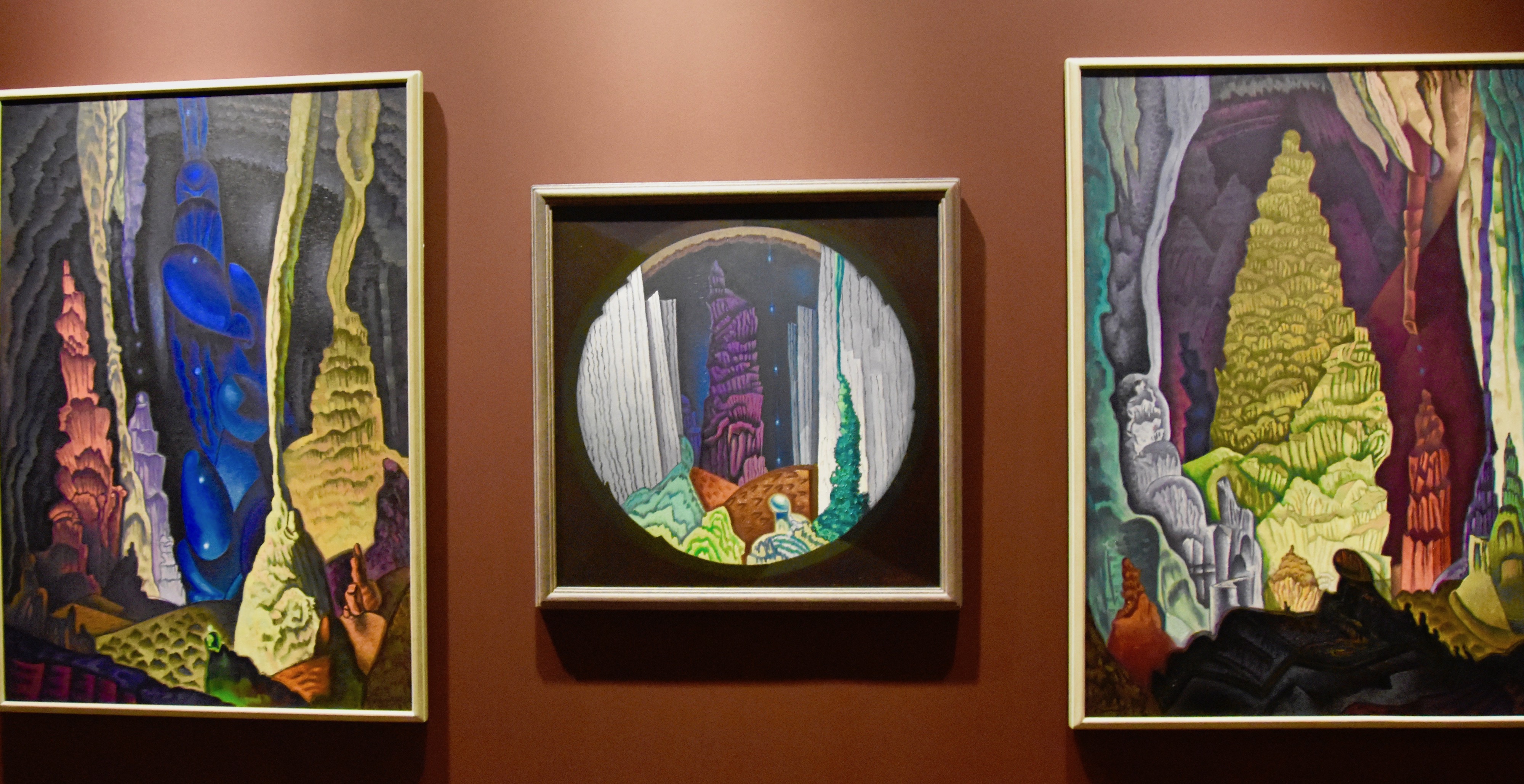
Naive or folk art is always an important part of understanding the ethos of a people and the Albuquerque Museum has a very good collection starting with these religious pieces.
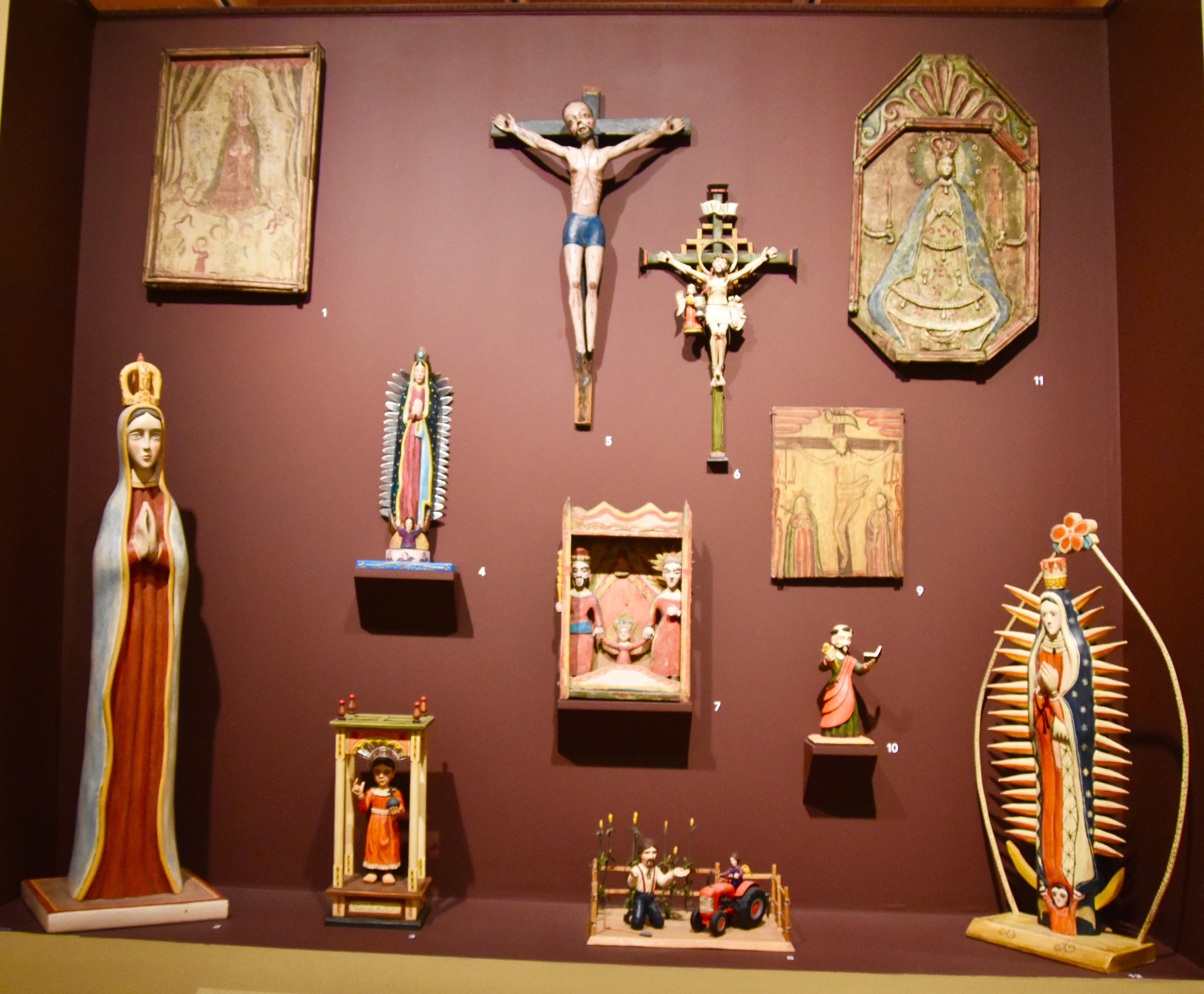
This original piece by Albuquerque native and self-taught artist Steven C. White depicts 28 country and western legends in an ascendant display with Hank Williams at the top. It’s fun to look at the detail that makes each singer readily recognizable, but I was disappointed that my home province’s Hank Snow did not make the pantheon.
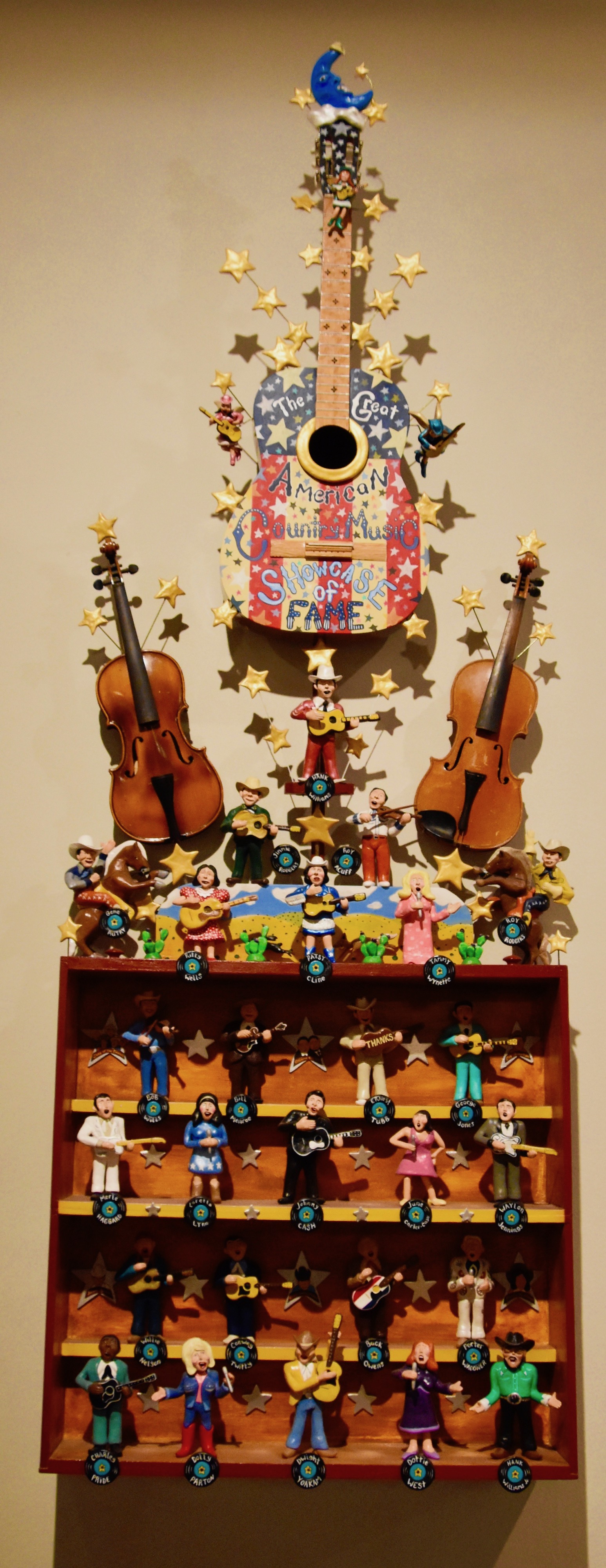
This blaze of colour, pun intended, is from pop art inspired John Fincher and it catches your eye from a good distance away. Simple, bright and effective.
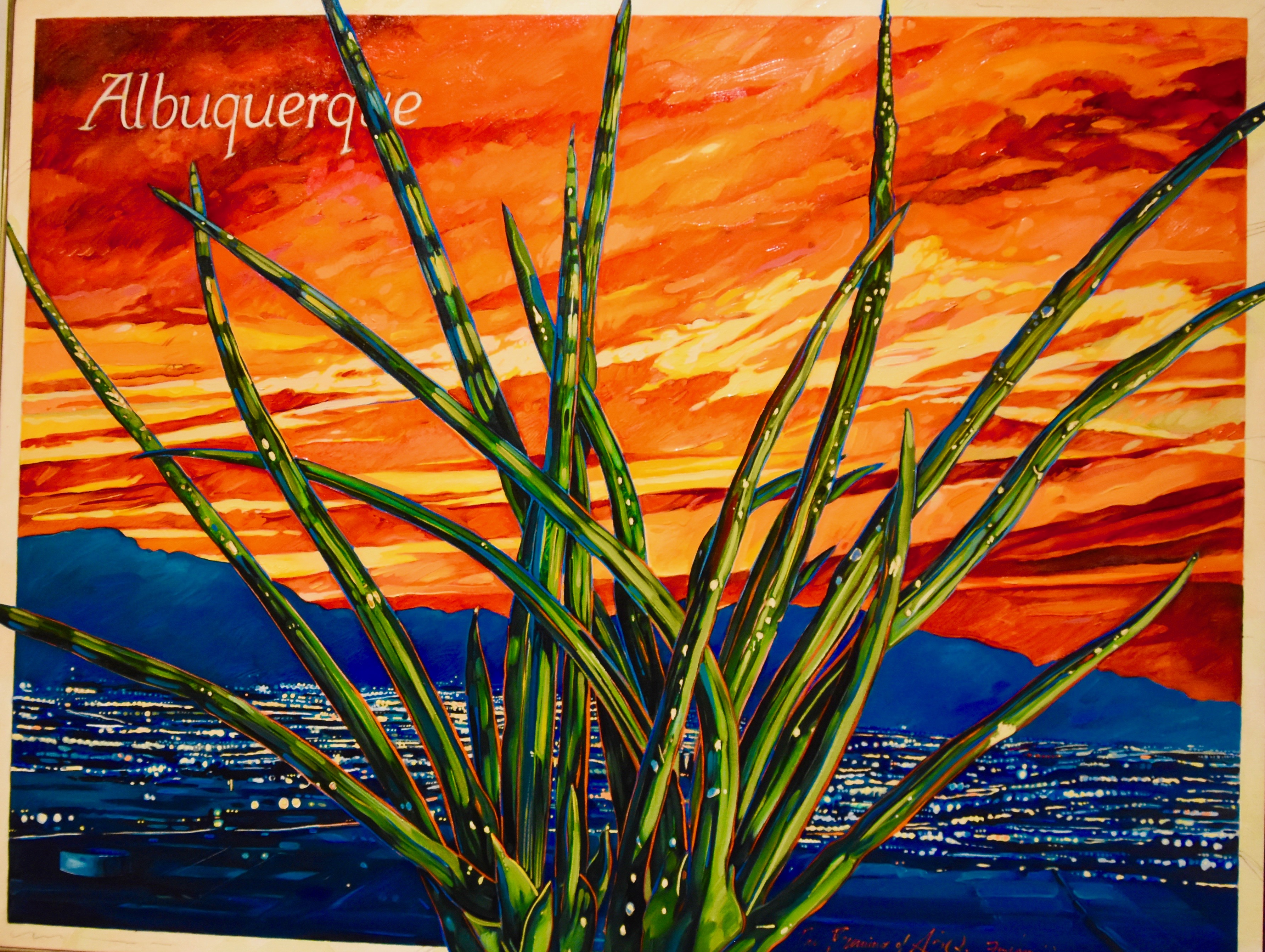
Although not a Native American, Paul Pletka has long been fascinated by their history and culture and how it has been affected by outside influences. That shows up dramatically in this painting which translates as The Body of Christ. Perhaps not surprisingly, unlike almost all the other paintings in the Albuquerque Museum, this one has no explanatory notes to help the viewer interpret what the artist is trying to convey. But I’ll give it a try.
Depicting Christ as a sphinx like church that symbolically devours his robot like adherents seems pretty obvious. Note that the one person not heading into the church, but just observing is a skeleton. Is the ladder there as an escape hatch? I looked at this picture for a long time which means the artist caught my attention and that’s a good thing even if what he is trying to get into my head is not.
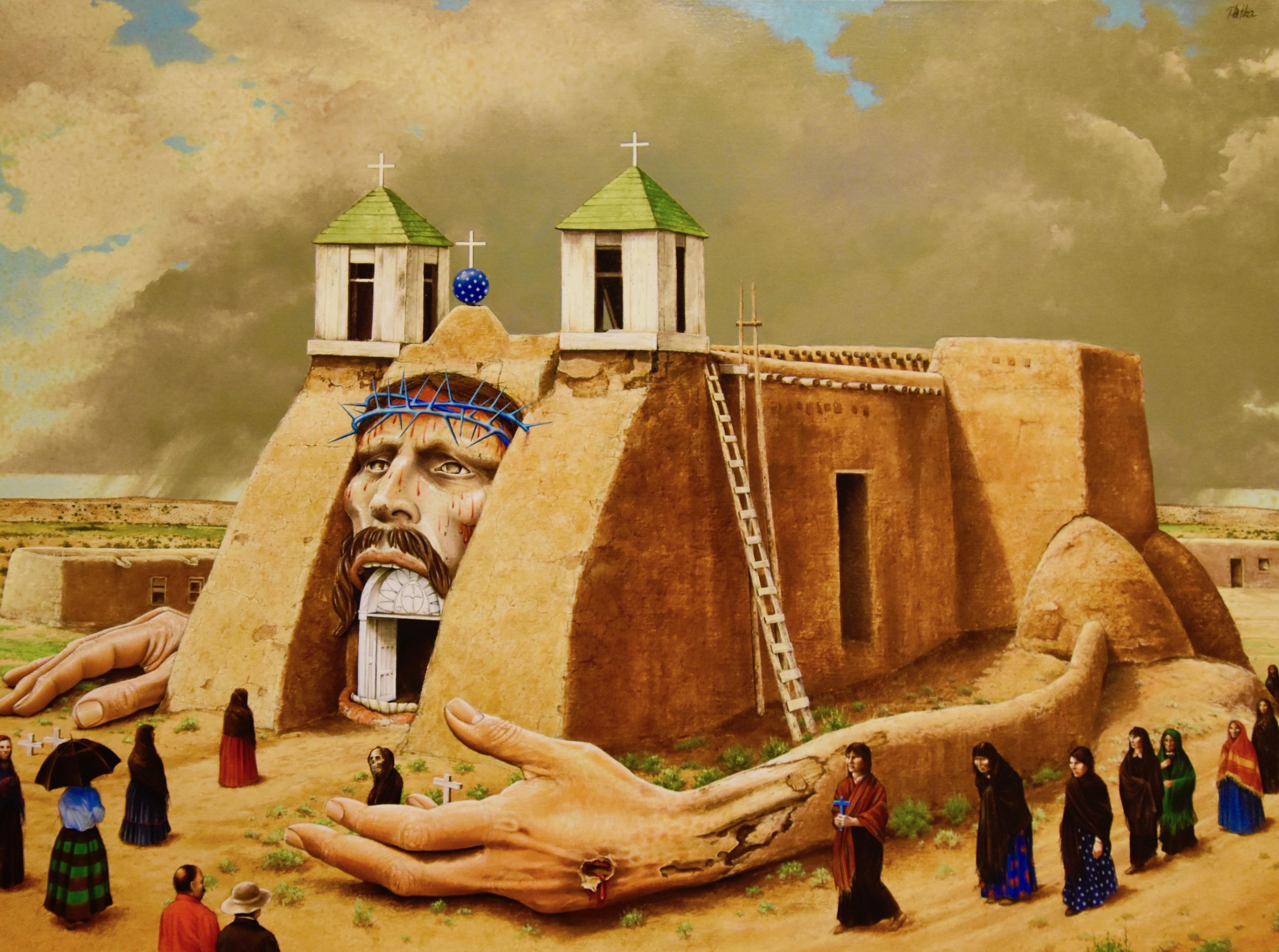
Next we have more religious symbolism in Luis Tapia’s Chima Altar – Ford III which the more you look at it the more you see like the eye of God in the rear view mirror and the Crown of Thorns as steering wheel. This piece reminds us that the Catholic religion is still very much a part of New Mexico’s Hispanic tradition. It’s also colourful as hell.
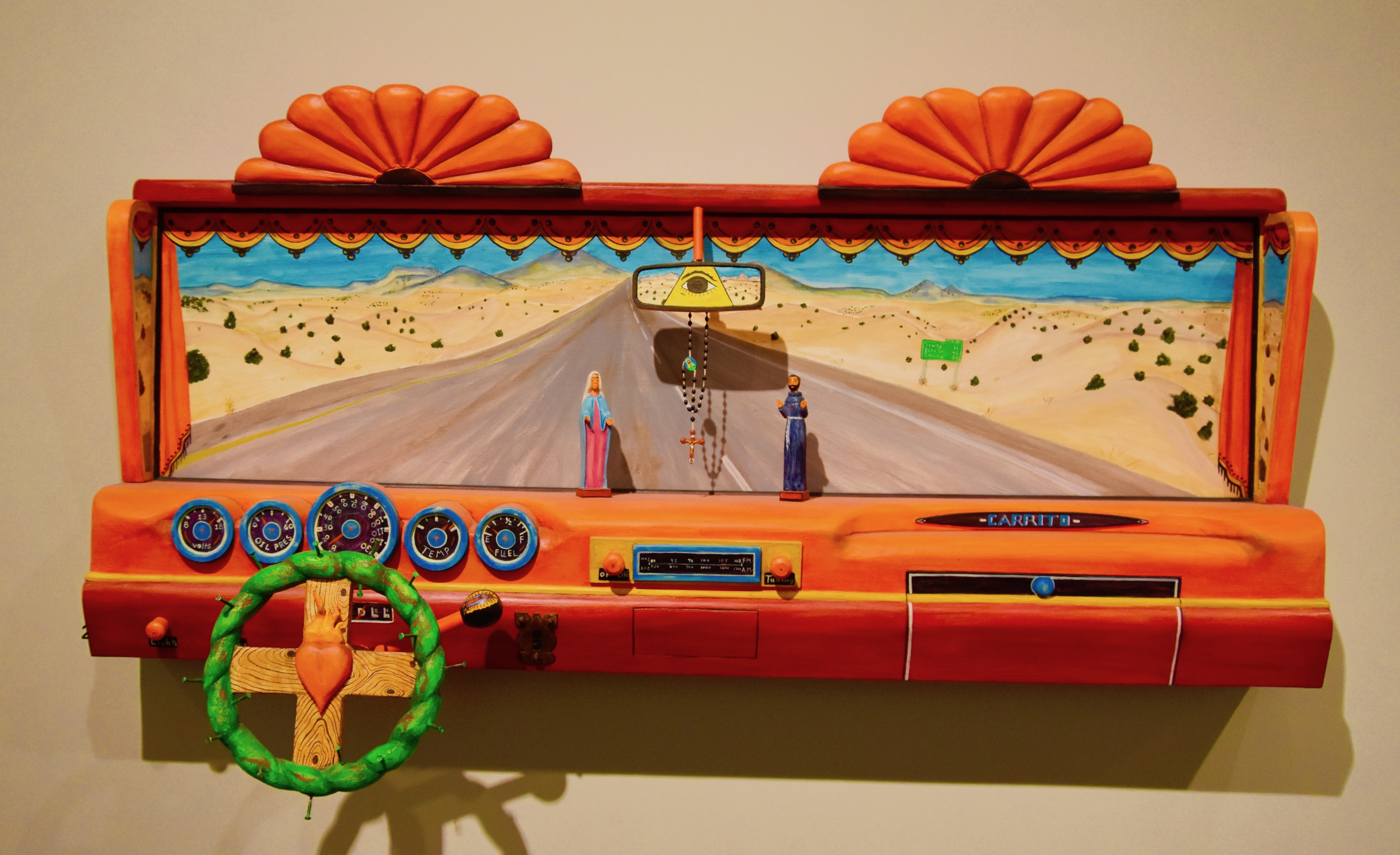
If by now you wondering if the Albuquerque Museum has any abstract art that question will be answered quite positively with one large gallery that is overflowing with it. I’m somewhat ambiguous about abstracts since so much of it is just plain crap, but the works on display here are pretty good and the room as a whole works very well.

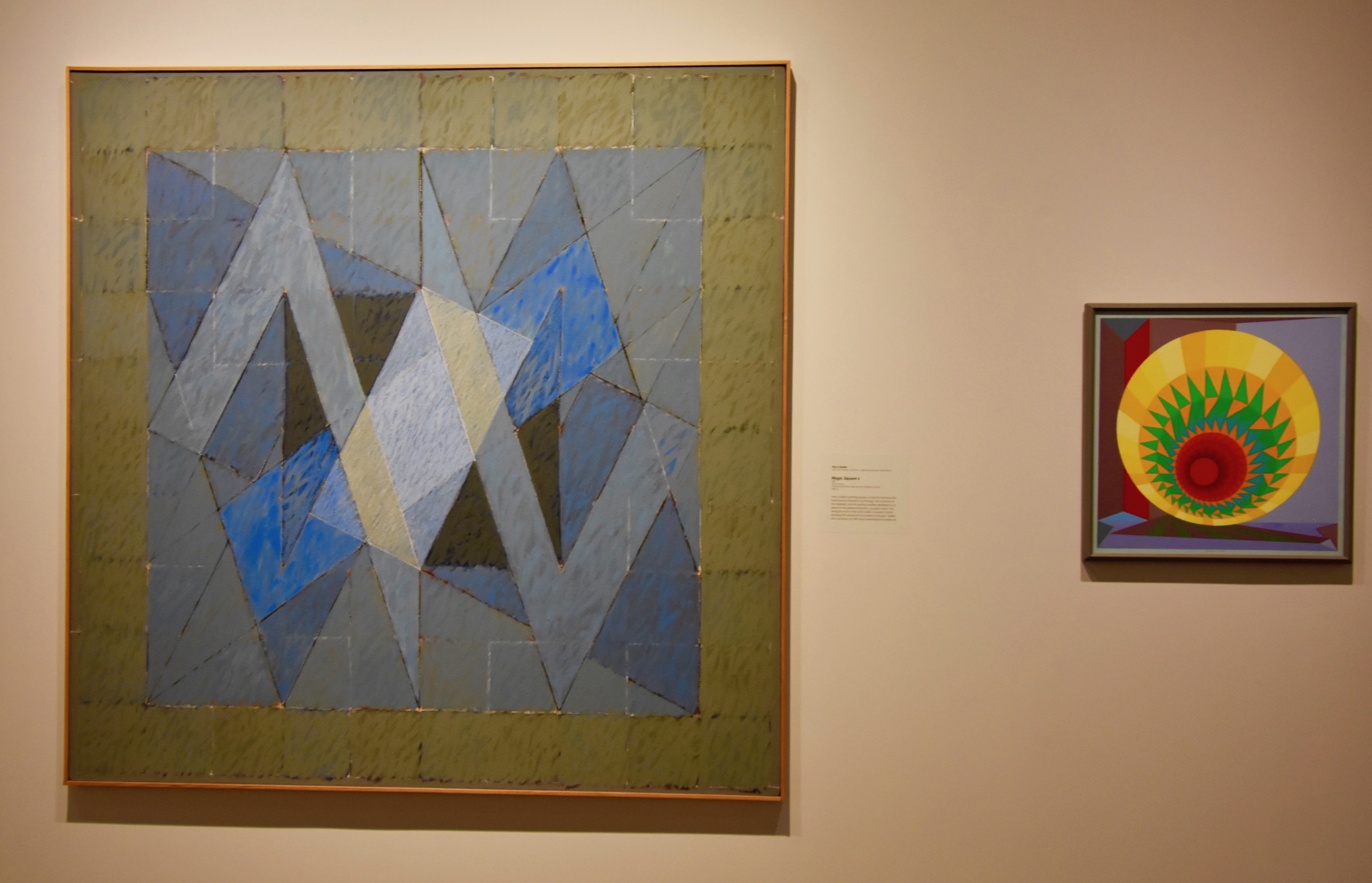
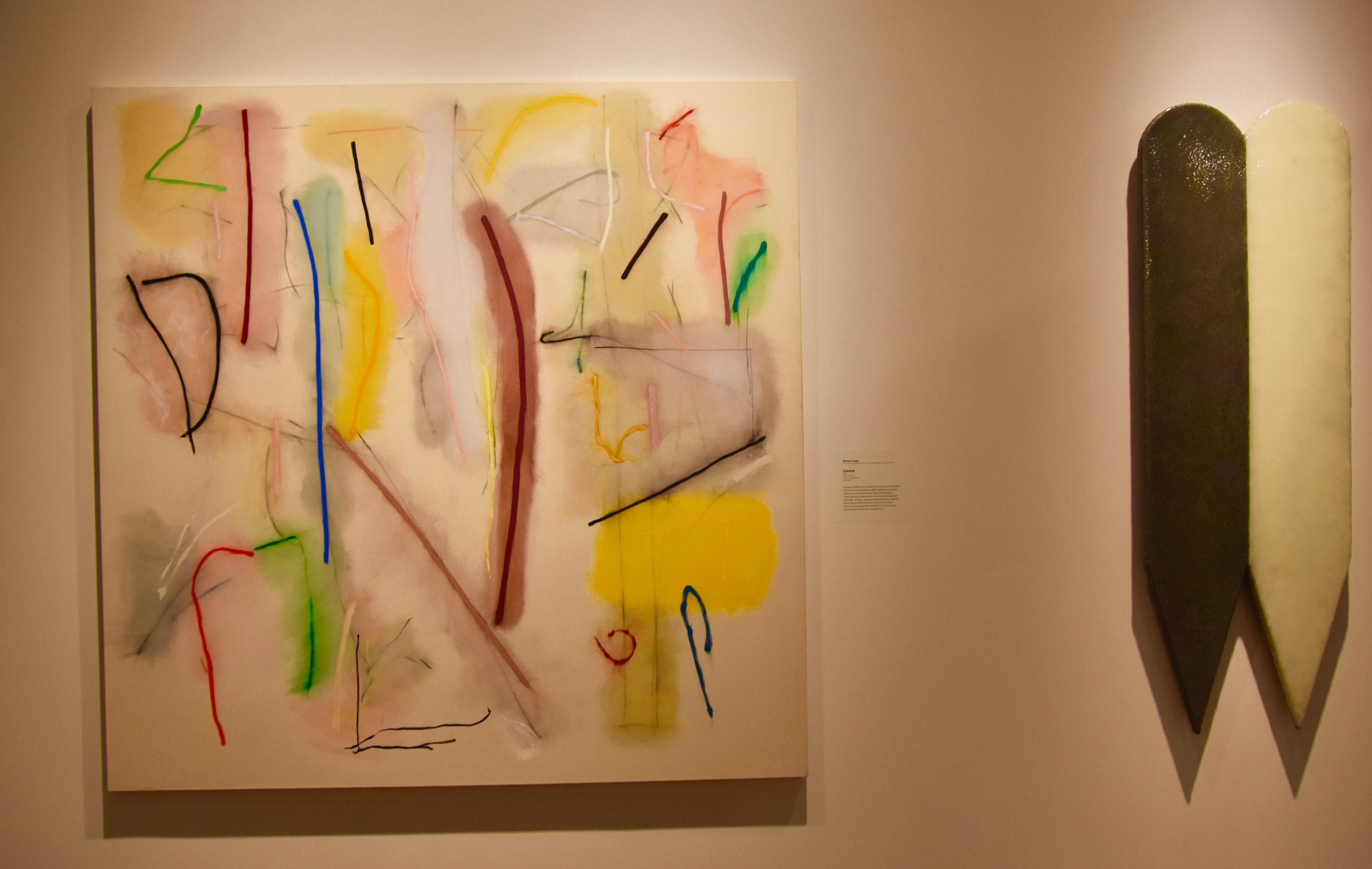
Back to more easier to interpret subjects like Rain Priest by Taos art colony artist Gene Kloss which continues the Native American motif with this powerful portrait.
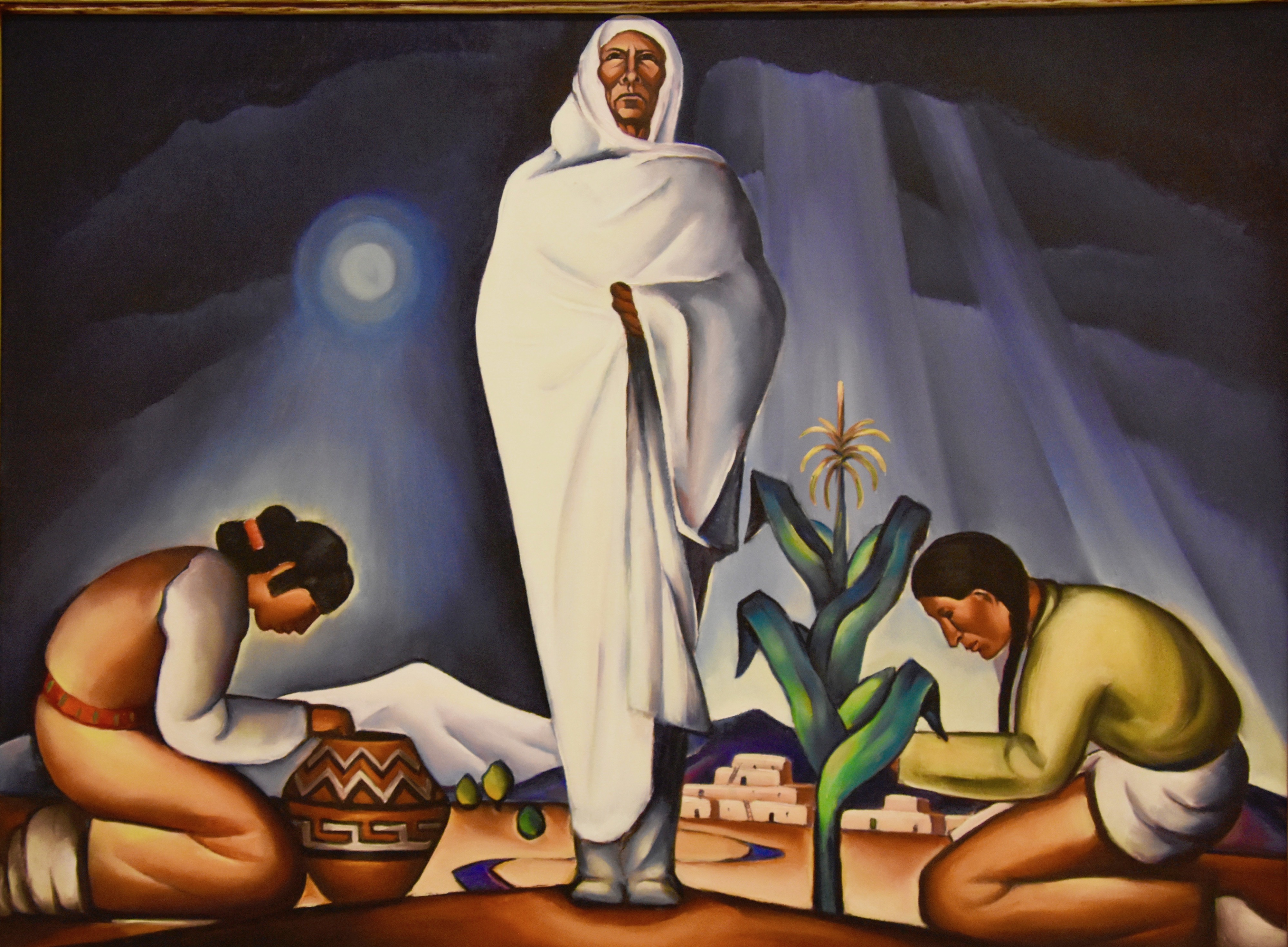
And one last work of art before heading outside again. This is Woe Man 1, a cast paper piece by Judy Chicago which perfectly captures the angst of modern life in this compelling face which seems to be asking whatever gods there might be up there – “Why?”.
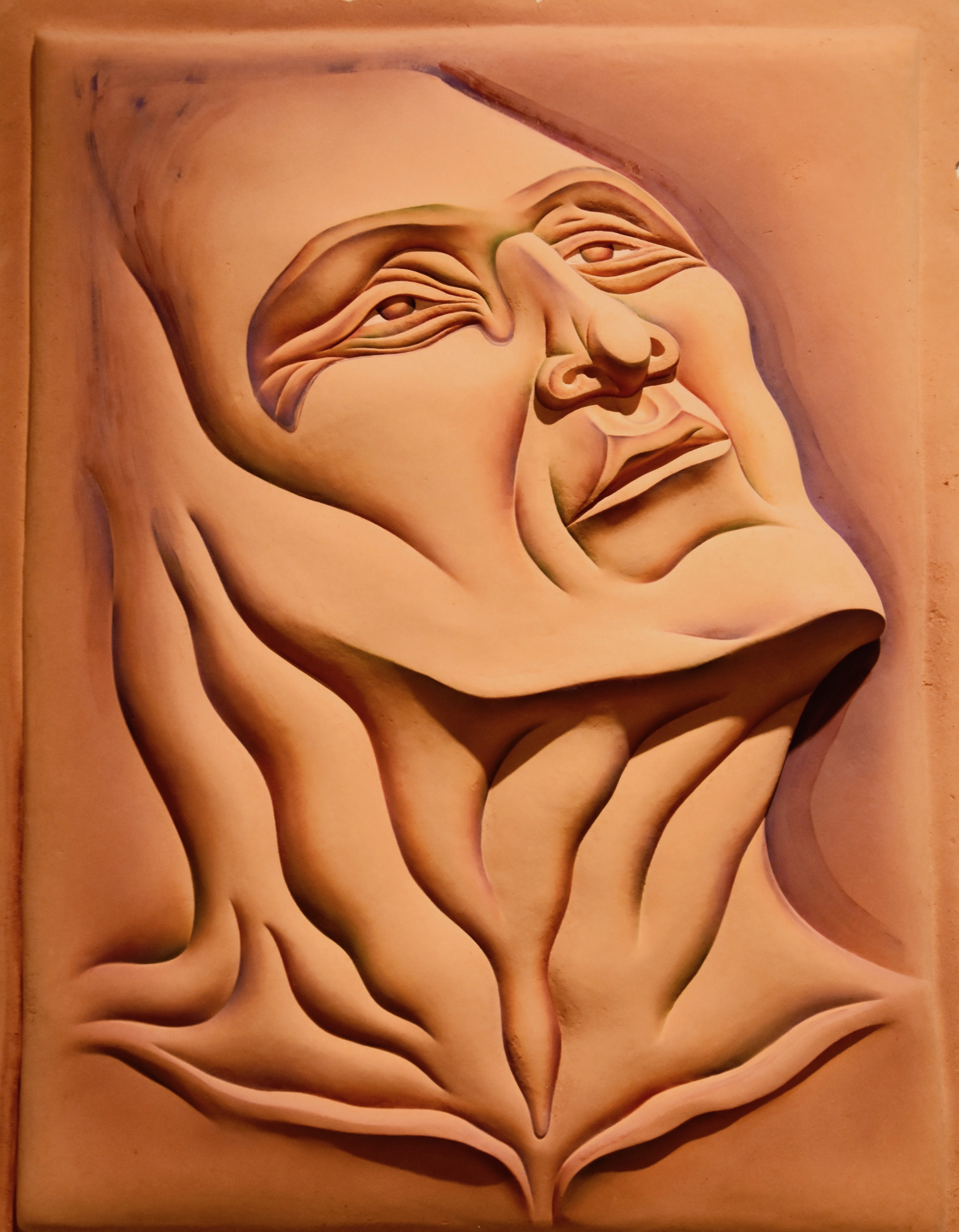
There is a second smaller sculpture garden at the Albuquerque Museum which can only be accessed from inside the building.
Don’t ask me why, but from the moment I stepped out into this courtyard I felt as if I had walked into a painting by Italian surrealist and practitioner of Metaphysical art, Giorgio de Chirico. Rather than being a series of art works this entire courtyard is really one big piece of art on its own.
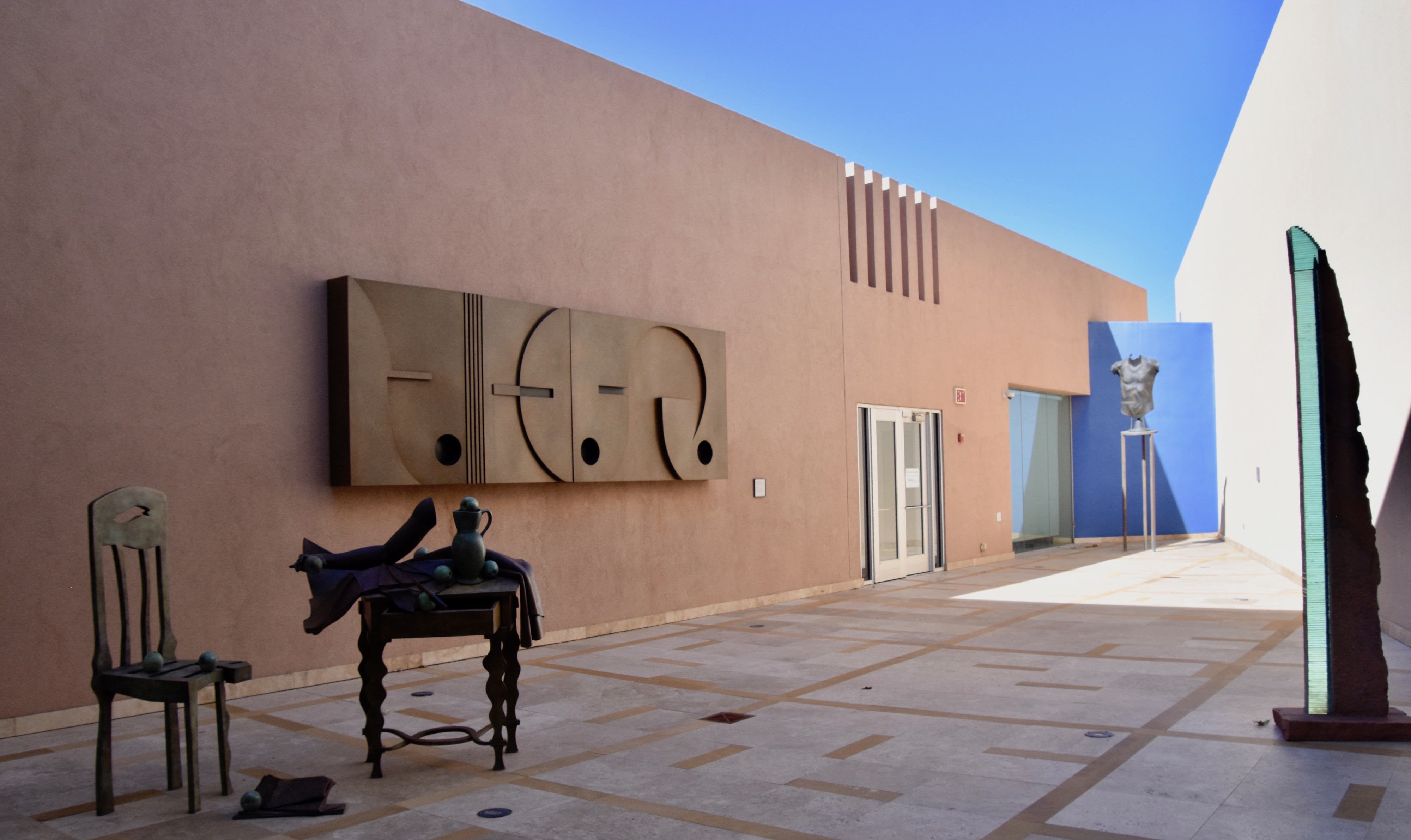
Take a look at his Mystery and Melancholy of a Street to see if I’m crazy or not.
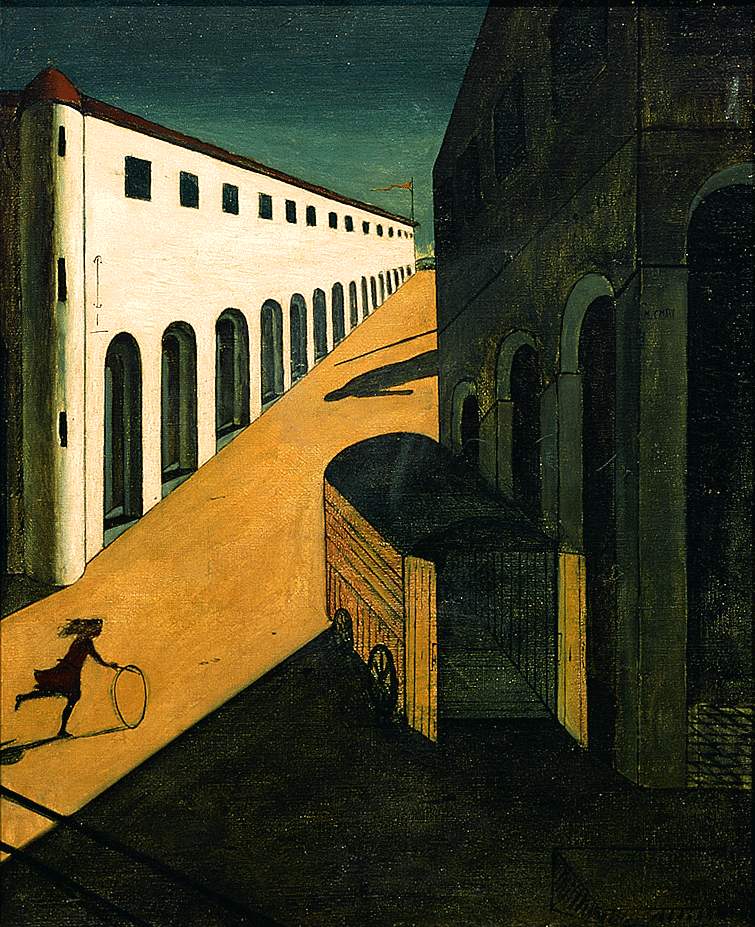
That concludes the art gallery portion of the visit. What remains is the history section contained in a series of galleries all housed under the Only in Albuquerque umbrella.
Only in Albuquerque
I have to confess that after being blown away by the art gallery I was less impressed with the history museum, perhaps because its focus was so much on Albuquerque that it would be of less interest to someone from out of the city. However, there was still a lot that was worth seeing.
Only in Albuquerque is divided into four distinct sections around the words Resourceful, Innovative, Spirited and Courageous. Maybe this is why it didn’t work so well for me because wouldn’t every city use words like those to describe its people and history? No one is going to use words like boring, timid, staid or complacent.
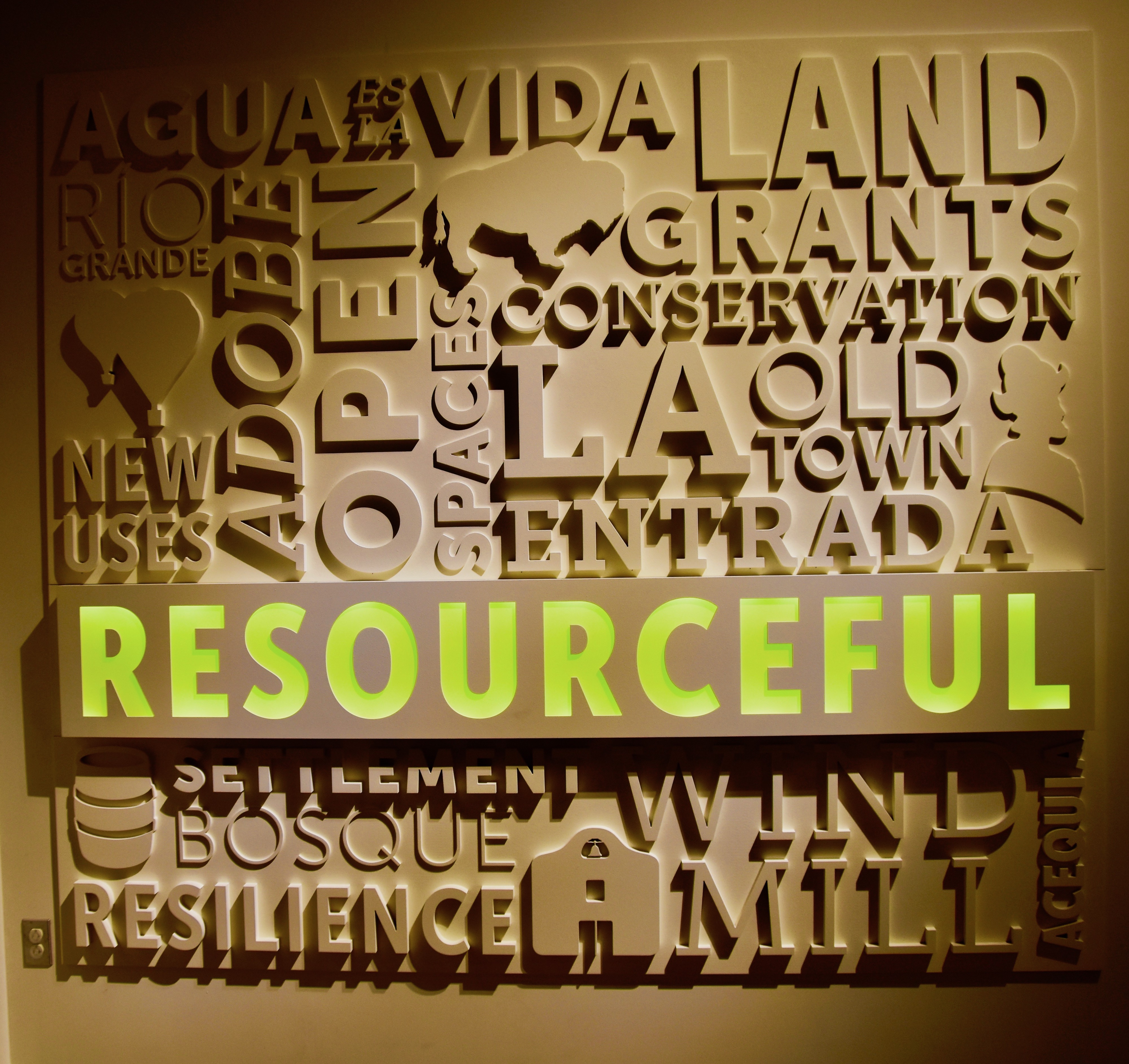
Anyway here’s what I did like. That beautiful quilt reminded me of the beginning of the visit where I had made my own/
.
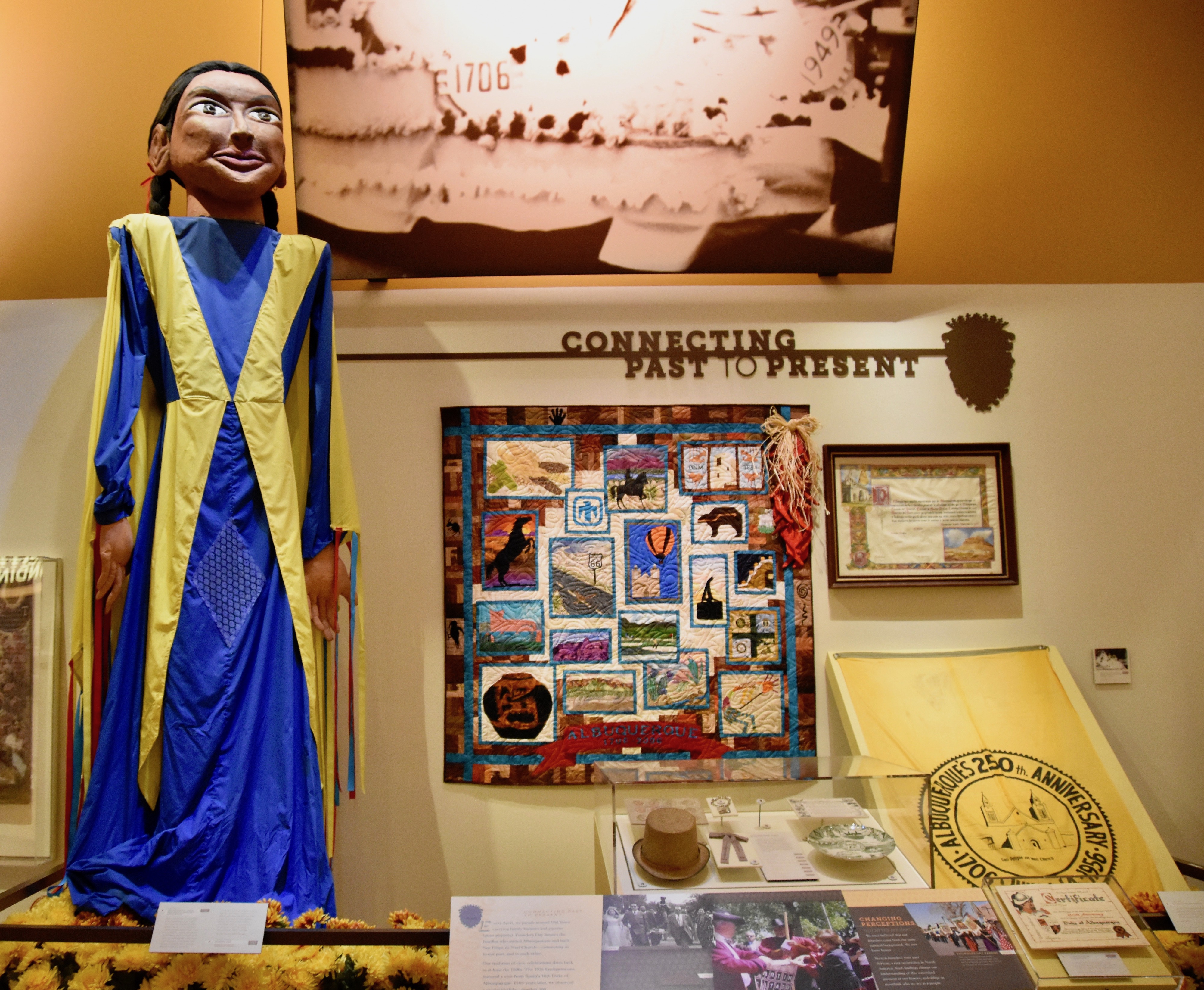
The Santa Fe Railway was, and its successor BNSF remains, a huge part of the Albuquerque economy and a vital cog in the development of the city. As the words say, the Santa Fe RR was a game changer.
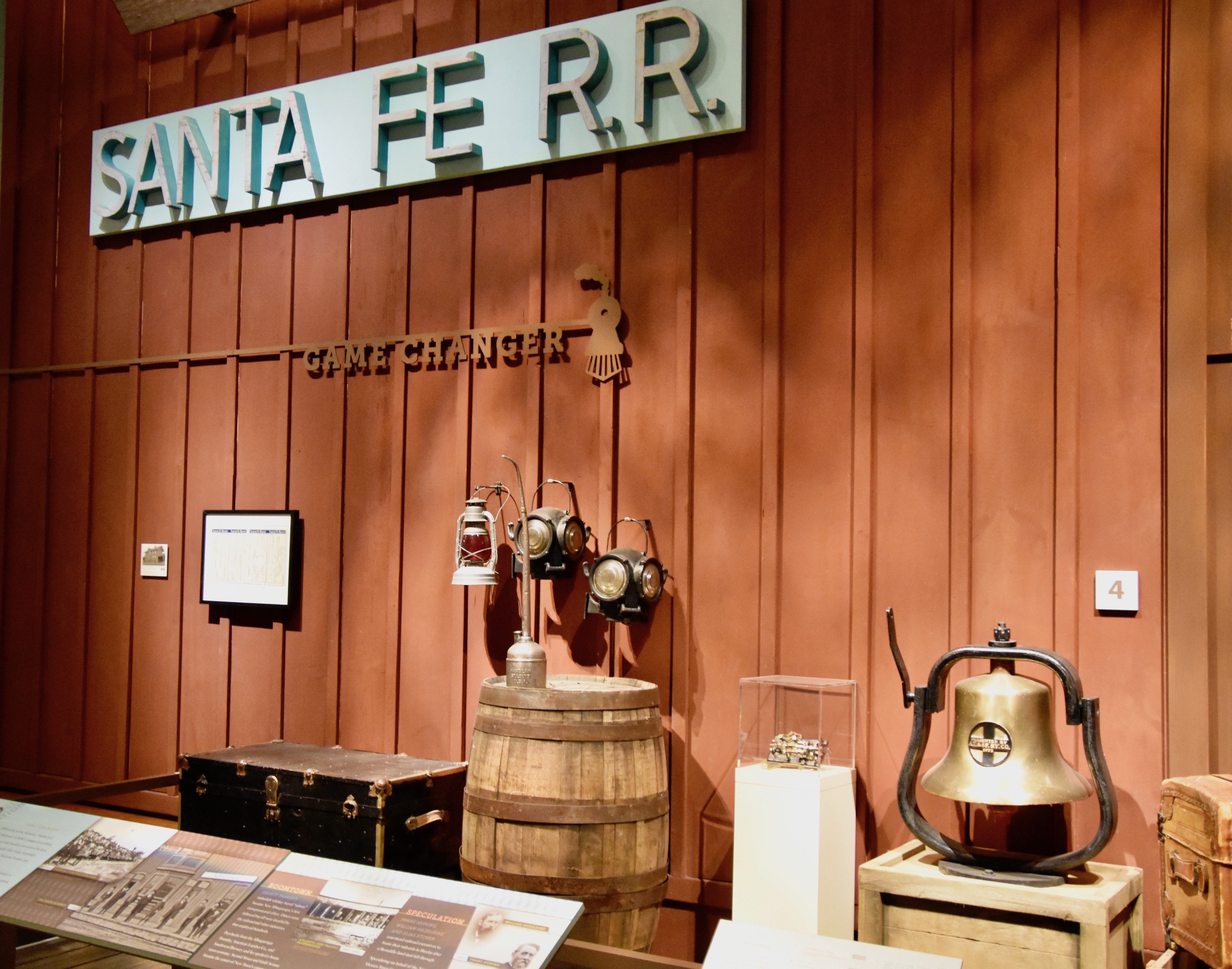
I also enjoyed learning the story of the Chihuahua Trail which linked that Mexican city to Santa Fe and Albuquerque, especially as we had driven those portions from El Paso to Chihuahua and from Socorro to Albuquerque. It also helped fill out the story of La Jornada which began before we even entered the museum. To a person living in the 21st century with the ability to travel thousands of miles in one day, it is simply unfathomable to imagine the hardships that people once endured just to go a few hundred miles.
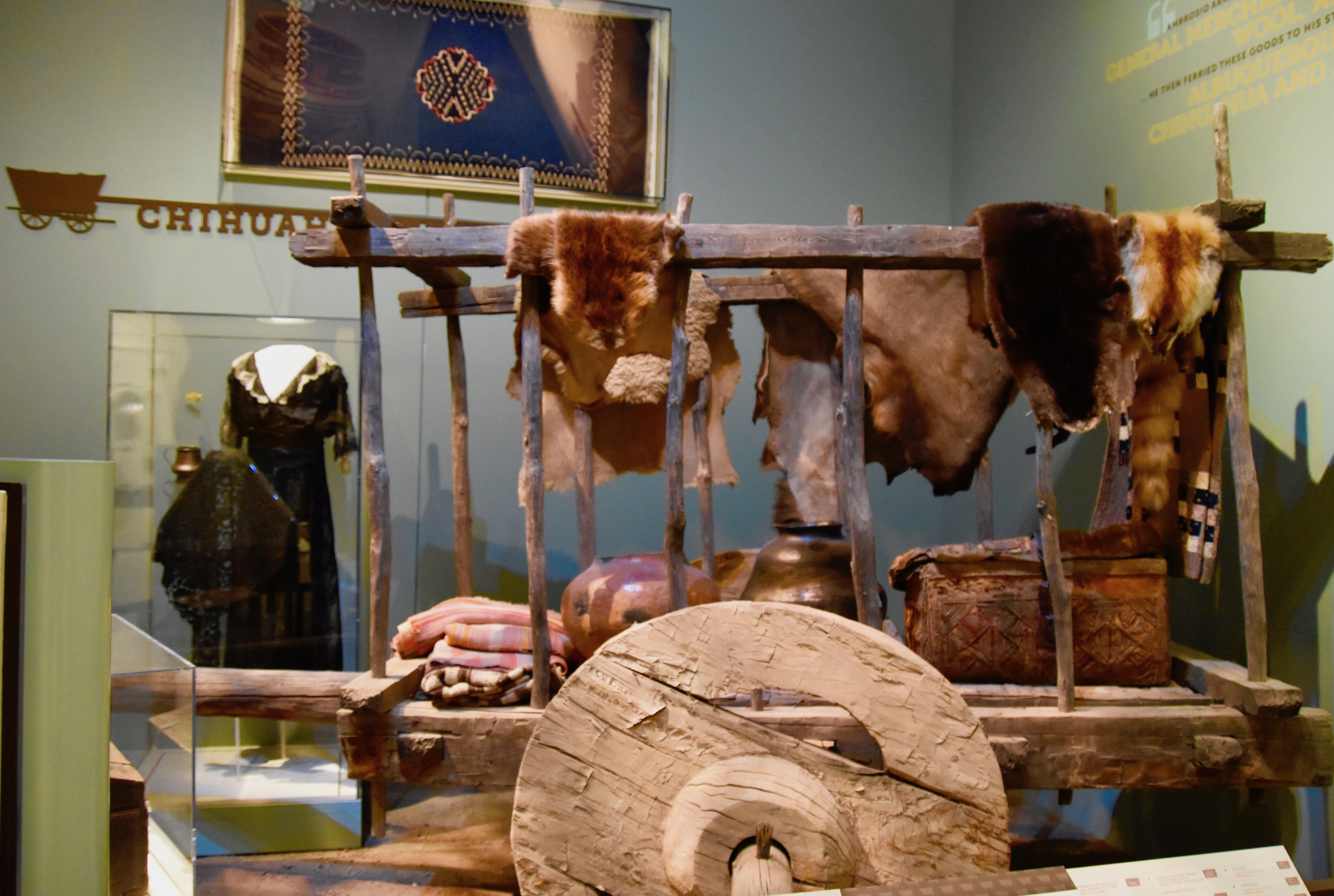
I have always been fascinated with the earliest Spanish expeditions into continental United States. In the east Hernando de Soto was ranging throughout Florida, Georgia, Alabama, Mississippi, Arkansas and Louisiana, becoming the first European to cross the Mississippi. At the same time from 1540-42 Francisco de Coronado was leading an expedition from Mexico through the states of Texas, New Mexico, Arizona, Oklahoma and Kansas. Yes, Kansas was explored a good sixty years before any European settlements were made either in Canada (Port Royal – 1604) or the eastern seaboard of the United States north of Florida (Jamestown – 1607). Even the oldest city in the United States, St. Augustine was still over two decades away from its foundation when Coronado was thrashing around Kansas looking for the Seven Cities of Gold. Heady stuff.
This is a diorama showing Coronado with two of his Native American guides. Can you imagine just how hot both horse and rider would be, ensconced in that armour during a New Mexico summer?
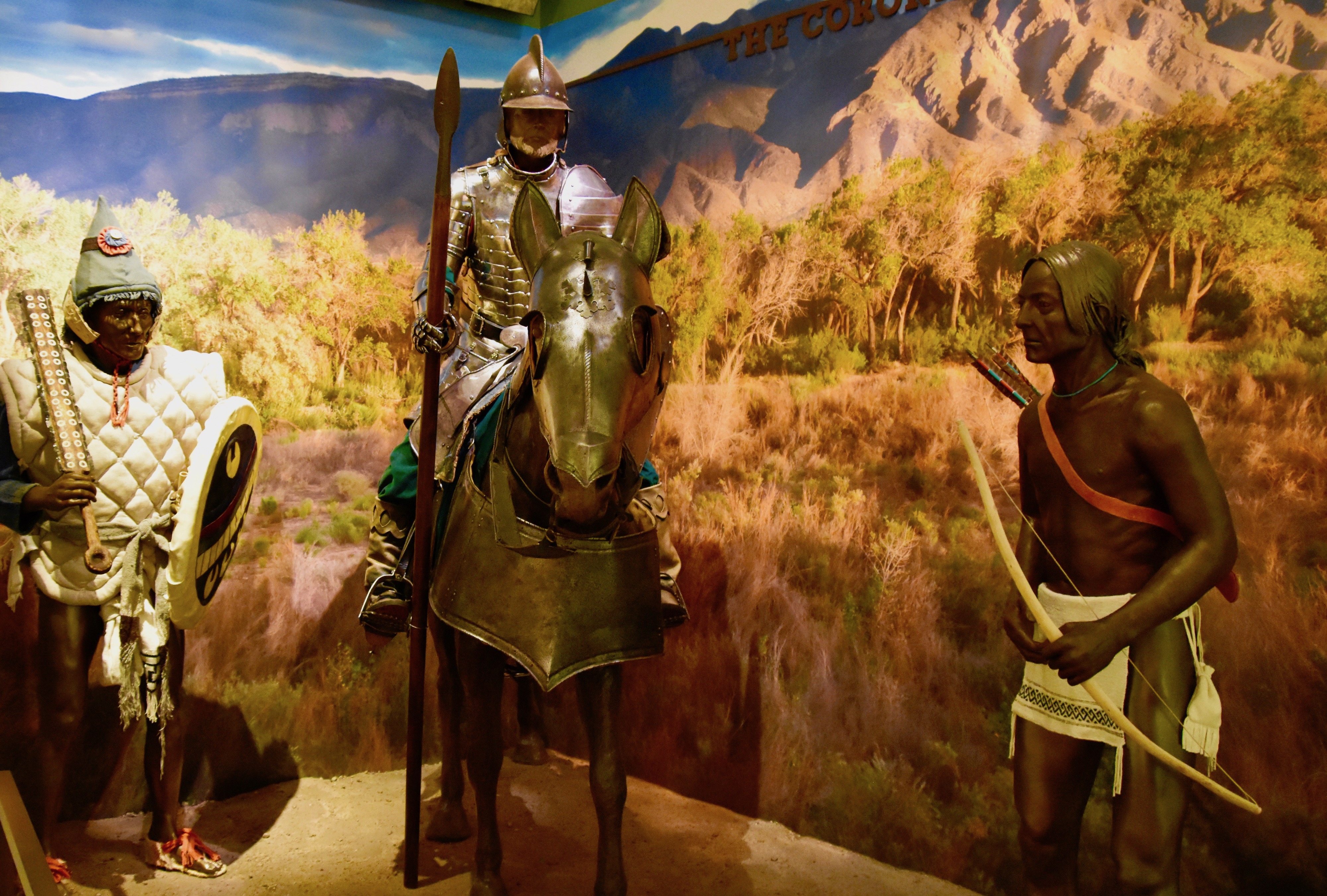
That concludes the major galleries at the Albuquerque Museum. What’s left is the de rigeur visit to the museum store, just outside of which is yet another amazing work by Luis Jimenez entitled Progress 1 which was the first large scale work he ever undertook. It shows a Native American riding a horse which helps him take down the buffalo as well as the rabbit, coyote and snake you can find if you look closely. Technically I guess the progress was the fact that the Spanish introduction of horses made these buffalo hunts a lot easier than before.
Remember we started this visit with a falling buffalo and we’ll end it with another.
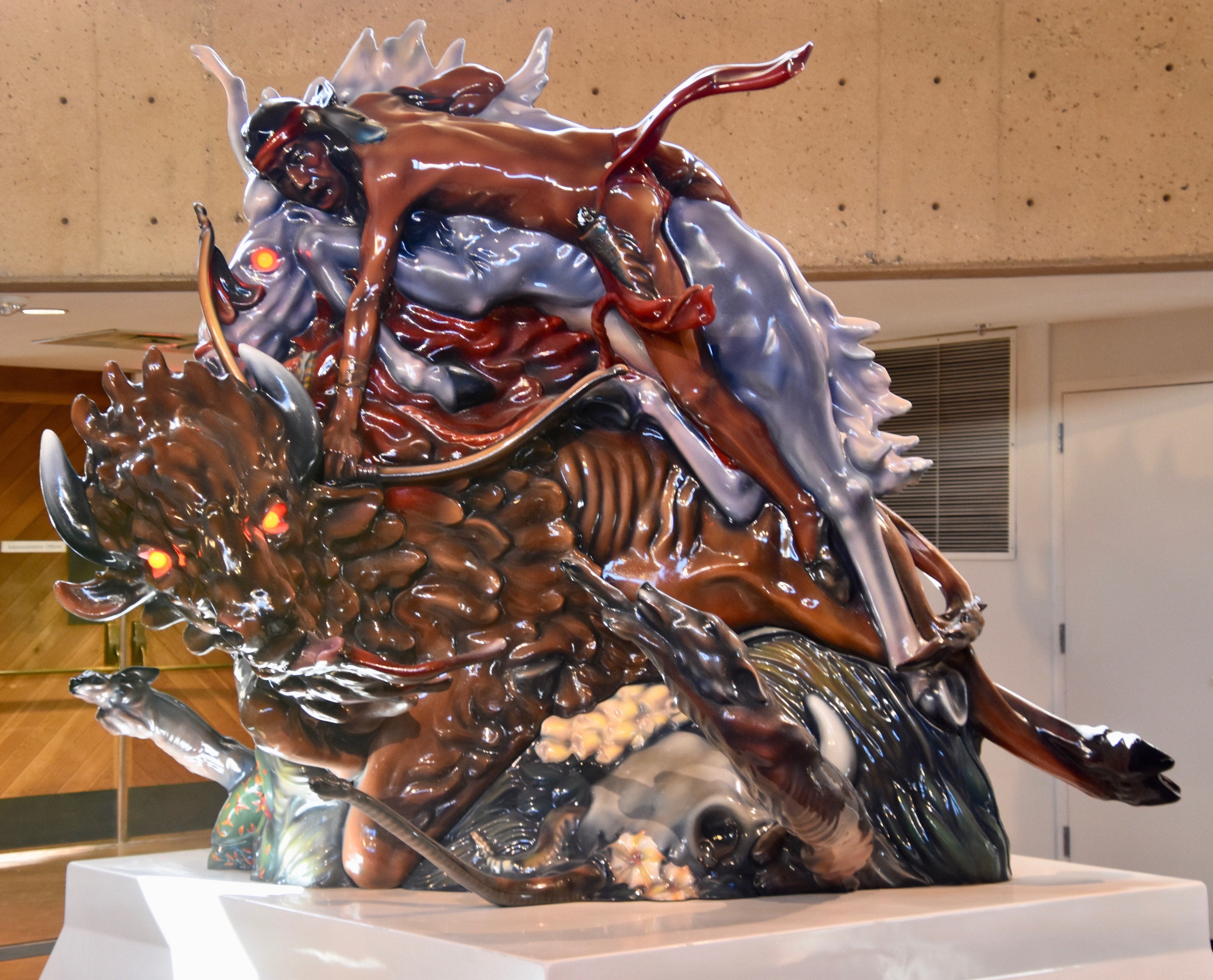
One last thing. How can I say that this is the best museum in New Mexico? Well, after visiting the Albuquerque Museum I visited the much more famous New Mexico Museum of Art and New Mexico History Museum both in Santa Fe. Frankly, both were disappointing, much more expensive and less informative than the Albuquerque Museum. True, the Georgia O’Keeffe Museum was closed so I can’t comment on it, but as it is dedicated to one artist it cannot possibly have the variety of the Albuquerque Museum. The bottom line is that if you find yourself anywhere near Albuquerque you need to visit this museum.
Next we’ll see a completely different side of Albuquerque as we look for Walter White on a Breaking Bad tour. Please join us.

